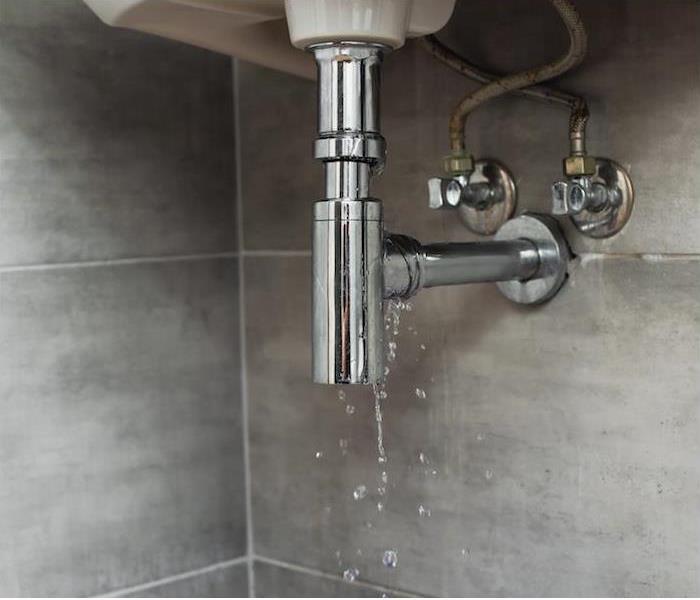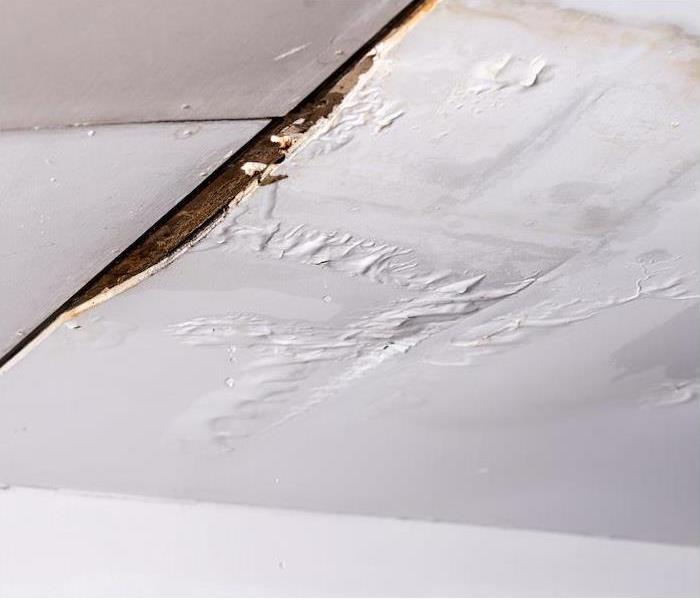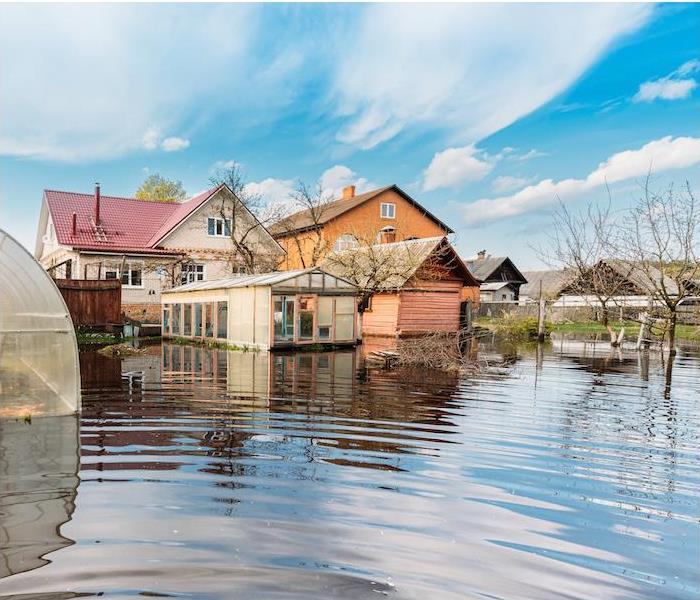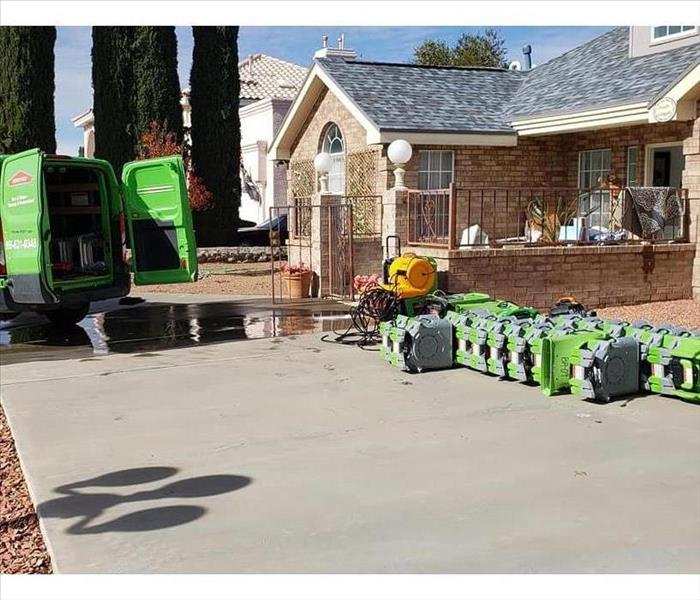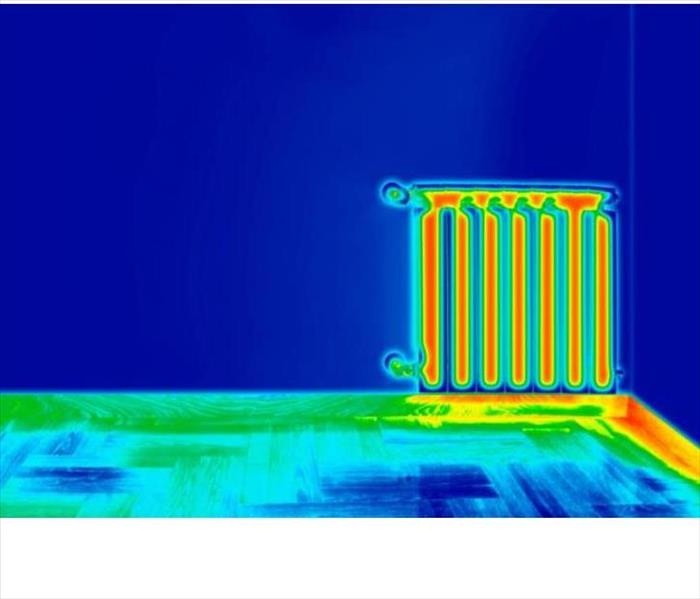Recent Water Damage Posts
Prepared All the Time: Keeping Your Home Ready for Flooding | SERVPRO® of East Brownsville & South Padre Island
11/15/2024 (Permalink)
Flooding is a common concern for homeowners in our part of Texas. Whether it’s due to tropical storms, hurricanes, or heavy rainfall, the risk of flooding can be high in this coastal area. Being prepared all the time can make a big difference in protecting your home and keeping your family safe.
Why Flooding is a Serious IssueBrownsville and South Padre Island have experienced significant flooding in the past. The area’s proximity to the Gulf of Mexico makes it vulnerable to hurricanes and tropical storms, which can bring heavy rains and storm surges. For example, Hurricane Hanna in 2020 caused widespread flooding in the region, damaging homes and roads.
With unpredictable weather patterns, it’s essential to recognize the flood risk isn’t just in the past. Future storms could cause similar or even more severe issues. According to FEMA, parts of Brownsville and South Padre Island are in high-risk flood zones, which makes flood preparedness critical for every homeowner.
How to Keep Your Home Ready for FloodingFlood preparedness isn’t just about reacting once the storm hits. There are practical steps homeowners can take to reduce flood damage before a flood event even occurs:
Install Flood Barriers and Elevate Utilities: Consider adding flood barriers around your property and raising appliances like water heaters, electrical panels, and HVAC systems to prevent water damage during a flood.
Maintain Gutters and Drains: Ensure that gutters, downspouts, and storm drains are clear of debris to reduce the chances of water pooling around your home.
Seal Your Home: Waterproof your basement and foundation, and check for cracks or weaknesses that could allow floodwaters to seep into your home.
Prepare an Emergency Kit: Keep a flood emergency kit on hand with essentials like food, water, flashlights, batteries, and important documents stored in waterproof containers.
What to Do After Flooding OccursEven with all the preparation, flooding can still happen. After your home experiences flood damage, quick action is essential to minimize further damage. This is where SERVPRO® of East Brownsville & South Padre Island can help. Our team of trained professionals is ready to assess and restore your property to its pre-flood condition.
Whether it’s floodwater extraction, drying, or structural repairs, SERVPRO® of East Brownsville & South Padre Island has the expertise and equipment to handle it all.
Be prepared for the next storm by keeping your home flood-ready. Visit SERVPRO® of East Brownsville & South Padre Island to learn more about how we can help you stay safe before, during, and after a flood.
Damage from Water Progresses Over Time | SERVPRO of East Brownsville & South Padre Island
9/10/2024 (Permalink)
That dripping faucet or small water spot may not seem like a big deal, but never underestimate how much damage water can do. In a year, the average household leak can lose up to 10,000 gallons of water.
Water moves quickly and causes destruction to floors, walls and other soft surfaces in its path. When an issue is addressed right away the damage done is greatly lessened.
Here is a basic timeline of water damage and what you need to know when water intrudes in your space:
<h2the-first-24-hours">In the First 24 Hours
Every household has a one in four chance of experiencing flood damage within 30 years of living in a high-risk area. Knowing what to do the moment you spot water is crucial.
The first 24 to 48 hours after flooding or any other water damage occurs are essential. Some belongings will begin to take on water and its ruinous effects immediately.
Upholstery and furnishings with soft surfaces will become saturated, while wooden structures will swell as they take on moisture. Books and photographs are vulnerable to warping beyond recognition. Additionally, mold will begin to form during this time. The faster action is taken the better the results will be.
At SERVPRO®, our mentality and expertise is to “restore vs. replace” so that we can protect your most precious items and save you money at the same time. If any damaged items can not be restored, we will communicate with you and handle removal as needed in order to continue drying out the rest of your home and materials.
<h2the-first-week">Within the First Week
After the first day, damage from moisture continues to progress further quickly. Mold spreads like a fire in an environment with excessive moisture, and the deeper it sets in, the more damage the home’s structure receives.
Wood surfaces and other porous items including walls will continually become compromised as metal surfaces will corrode.
<h2one-week">After One Week
Allowing moisture to sit for any length of time should be avoided as much as possible as the effects could be total destruction. The more time that passes the more cost, efforts and risks increase.
<h2SERVPRO-will-help">How SERVPRO Will Help
SERVPRO will start their process with the very first call, with the best results coming if the call is made in the first 24 hours. Work begins with removing as much water as possible to prevent any additional spread or damage and reduce total drying time.
Floors, furniture and other belongings will likely need to be cleaned, sanitized and deodorized. Once the majority of water has been removed, our specialized team will use industry-leading equipment to dry water you can’t even see.
Once these steps are complete, we will begin assessing for any needed construction to your property in order to restore your home back to preloss condition. This could include a minor repair or a complete rebuild of an area of your home.
SERVPRO is a full-service company and can simplify your recovery process by handling everything from initial damage mitigation to any required rebuild. We will stay in constant communication with you every step of the way to get you back in your home faster.
Regardless of the type of water damage sustained, SERVPRO has the tools and teams to help your home or business recover. Contact us 24⁄7 when you need a dependable team to help you recover.
Prepping for Fall: Water Damage Prevention | SERVPRO of East Brownsville & South Padre Island
9/3/2024 (Permalink)
 Safeguarding your home from water damage is easy this Fall with these insights from SERVPRO of East Brownsville & South Padre Island!
Safeguarding your home from water damage is easy this Fall with these insights from SERVPRO of East Brownsville & South Padre Island!
As the summer heat starts to mellow out, and the crisp air of fall sets in Texas homeowners must be vigilant against water damage that often accompanies seasonal changes. Here’s how you can safeguard your home and why SERVPRO of East Brownsville & South Padre Island is your go-to partner in keeping your property safe and dry.
Understanding Fall Weather in Our Part of TexasBrownsville, the Islands, and our surrounding communities experience a unique blend of weather patterns during the fall. This region, nestled at the southern tip of Texas, sees average temperatures ranging from the high 70s to low 90s in October, which cools down to the 60s and 70s by November. Rainfall is relatively moderate, with October seeing an average of about 4.5 inches, which decreases slightly as the season progresses.
These weather conditions can be misleading. The cooler temperatures might make you think your home is less susceptible to water damage, but this is not the case. Fall showers can still lead to water accumulation around your home’s foundation, leaky roofs, and clogged gutters, all of which can cause significant damage if not addressed promptly.
Essential Tips to Prevent Water DamageInspect and Clean Gutters: Falling leaves can clog your gutters, causing water to overflow and damage your home’s siding and foundation. Regularly clean your gutters and downspouts to ensure water flows away from your home.
Check Your Roof: Inspect your roof for missing or damaged shingles that could lead to leaks. Water can seep through even the smallest cracks, so it’s crucial to repair any issues before the rain sets in.
Seal Windows and Doors: Make sure all windows and doors are properly sealed. Gaps and cracks can let in moisture, leading to water damage and mold growth.
Inspect the Foundation: Look for cracks or areas where water pools near your home’s foundation. Seal any cracks and consider grading your yard to direct water away from your home.
Install a Sump Pump: If your home is prone to flooding, a sump pump can help prevent water from accumulating in your basement or crawl space.
Partner with SERVPRO of East Brownsville & South Padre IslandDespite taking all necessary precautions, water damage can still occur. In such cases, the quick response and expertise of a professional team are invaluable. SERVPRO of East Brownsville & South Padre Island is equipped to handle any water damage emergency. Our experienced technicians use state-of-the-art equipment and techniques to ensure your home is restored to its pre-damage condition.
Don’t wait for water damage to catch you off guard this fall. Take proactive steps to protect your home and rely on the trusted services of SERVPRO of East Brownsville & South Padre Island.
Visit our website to learn more about our services and how we can help you safeguard your home against the elements.
Dealing With Odors After a Water Leak | SERVPRO of East Brownsville & South Padre Island
5/1/2024 (Permalink)
 Trust SERVPRO of East Brownsville & South Padre Island to provide comprehensive services for a full recovery for all your restoration needs.
Trust SERVPRO of East Brownsville & South Padre Island to provide comprehensive services for a full recovery for all your restoration needs.
Picture this: You get home and find water all over the floor. That’s not the most wonderful image, especially if you have been away from home for more than a few hours! It could be from the dishwasher, the refrigerator or simply just an open window during a rainstorm.
No matter where water damage came from, cleanup often requires much more than just a few towels or a mop and bucket. Water moves incredibly fast, and it can find its way into lots of places you may never think to look.
The faster you can get a professional’s help when a leak strikes in your home, the better.
Addressing Water LeaksWhen water starts seeping throughout your home, it can damage floors, cabinets, walls and anything else in its path. Even after you have dried up water under furniture or appliances, it could still find its way into places that are pretty challenging to reach.
As you do clean up a visible water leak, make sure to pay close attention to what walls and flooring are around the leak area. Water under carpets or behind walls won’t dry on its own. These spaces are too tight and don’t have enough airflow to allow for evaporation. Instead, moisture can linger long-term—creating more and more damage the longer it goes unaddressed.
Eventually, the structure of your home will even be affected. Metal support systems will rust, while mold begins to set in on every organic surface it can find. Mold moves quickly, and in a short amount of time, you can be dealing with major outbreak
Following Your NoseAs mold begins to set up, it create a musty odor. If you smell something earthy and damp, there is a good chance something bad is happening out of sight. Use your nose to attempt to locate the source, but whether you can see signs of mold or not, it is time to call in our professional restoration experts.
Our team is highly trained in handling everything that comes along with water damage, including mold and odors. We will repair or replace warped floors and damaged walls. We can even rebuild parts of your home that are severely damaged.
Our crew will also seek out and stop mold growth, sealing any areas as needed in order to ensure it doesn’t come back. Everything in the area will be sanitized to start eliminating smells.
Once we know the problem area is well-cared for, we will go beyond where the leak was and make sure HVAC vents are clean and your air is filtered. Surfaces will be disinfected, too. Our goal is to make your space feel—and smell—like yours again. Whatever that takes, we’ve got it handled!
Don’t ignore signs of a water leak. Contact SERVPRO® for a full recovery.
What to Know About Water Seepage | SERVPRO® of East Brownsville & South Padre Island
4/29/2024 (Permalink)
You may not be aware of water leaking into your house, but there are ways you can detect an intrusion. Lowered air quality including a damp or musty smell, cracks, and peeling paint can all indicate that your home is taking in moisture that could lead to damages in your home’s foundation.
A leak in the house can lead to damages, including rusted appliances. While there are several indicators to watch for, the most obvious one will be water on the floor.
Learn the causes of water leaks in order to avoid damages that could become extensive to your home.
Water Fixture LeaksSinks are one of the common sources of water leaks in the home. A hole in a water line or deteriorated caulk around bathtubs, toilets or showers can lead to seepage.
Take the time to check around these areas regularly, and stop leaks before they can cause extreme damages. A tiny leak can lead to more than a thousand gallons of wasted water each year.
Water From AppliancesAppliances are a common source of leaks in the house. Refrigerators that have an ice maker or other water source and dishwashers are two appliances that have a high risk of unseen longterm leaks that could lead to damages to your floor that will require extensive and costly restoration.
To look for an appliance leak, unplug water-containing appliances and then pull them away from the wall. Check behind them and underneath them for puddles, damp spots or mold growth. Call us if you notice any issues to get things taken care of quickly and correctly before the disaster can worsen.
External SourcesNot all water leaks come from the inside, though. There are external sources that could lead to a slow leak that creeps in through windows and doors or a full flood if the weather turns intense.
We have seen flooding in our area from multiple sources, including coastal flooding and heavy rain storms that brought flash flooding. We have also contended with hurricanes that brought storm surges and high water levels to all of our water sources. It is essential for everyone in this area to have a flood plan in order to keep their home protected.
Fortunately, you can create a plan to manage these risks. You need to prepare your home and maintain a prepared home all year in order to ensure water stays out and to avoid damages.
Keep an eye on your gutters, downspouts and roof as the first way of protecting your house. Gutters that are filled with leaves can cause overflowing water that trickles down through the roof and damages the walls or foundation. Keep the area around your downspouts clear, and clean your gutters on a regular basis to keep water moving away from your home.
Your windows and doors should also be checked periodically to ensure their seals are secure. Seals that have loosened or broken down let excessive moisture enter your home that can promote mold growth.
The landscaping around your property can help move water away from your home. Create slopes outside your home with organic materials in order to protect your basement from water intrusion. When your home is ready for anything, you can rest well knowing you are protected.
If you experience water damage inside your home or business, call us, 24⁄7. We have the experience and equipment to get your property back in working order fast.
Flood Prevention Inside the Home and Out | SERVPRO® of East Brownsville & South Padre Island
4/23/2024 (Permalink)
Protecting your home from flooding is important for everyone, all around the nation. Just an inch of water can mean substantial damage and can cost you a huge amount of money for repairs.
If your neighborhood isn’t one at risk for frequent floods, you may not qualify for financial assistance with your insurance or with federal sources. Therefore, any preventative measures you can take are essential.
We have seen year after year the challenges that flooding poses being so close to the Gulf. Our corner of Texas has experienced river flooding, coastal flooding and storm surges that have taken out entire neighborhoods. Take the time to check on your home’s risk factors and learn as much as you can about the risks our region faces.
<h3your-home-from-the-outside">Protecting Your Home From the Outside
Sometimes flooding can’t be predicted, and an unexpected rain will leave yards and gutters drenched. Get your home ready from the outside in and lower the risk of damages to save on repairs.
Clean out your gutters to keep them clear of debris, sticks and leaves so water can flow away from your property. Extended downspouts are also an effective and inexpensive addition that will keep water moving in the right direction.
Organic materials like mulch can aid in protection when added near your home in a downward slope. Water will roll away from your foundation, and puddles will be avoided.
Landscaping can also be a great preventive tool and ensure that water doesn’t gather and enter into your home. Gardens are highly absorbent when heavy rains roll through. Water is pulled down into soil and roots rather than soaking your lawn and creating puddles.
There are a few upgrades to your home you could invest in for protection in all kinds of weather. Newer homes on the Island or near the coastline may already include raised electric and anchored fuel tanks, but if you are in an older home or farther away from water, adding these can offer protection when flooding occurs.
While these can cost a bit, something as simple as adding a rain barrel that collects water directly from your gutters is a cost effective way to keep water from ponding or puddling. It is also a great way to water the plants you added to your yard!
<h3protection-from-the-inside">Flood Protection From the Inside
A firm foundation and well-sealed basement are the best forms of protection for your home when it comes to external sources of flooding.
If your foundation is cracked, seal it. Install a sump pump in your basement or bottom floor that will pump any water out that comes in, and if your area is high-risk, spring for a battery-operated pump that will continue working even when the power goes out.
When a flood doesn’t come from outside, you can protect your house with easy home maintenance.
Pipes are one of the most common sources of water disasters in the home. Take care of pipes that have aged and be sure to stop leaks in order to prevent failures. Include checking your plumbing as a normal part of your house-cleaning routine in order to catch issues early.
Adding a sensor that detects leaks can also be a way to mitigate damages from water. Some security systems offer this add-on, so if you have been considering updating or adding a new system to your home, go for the upgrade. It will offer you a lot of peace of mind knowing that if water is flowing when it shouldn’t be, you can stop it fast.
Any kind of floodwater will damage paper goods and photographs right away when it takes over your home. Keep items that cannot be replaced stored up high or in a waterproof container. Your emergency contacts should also be stored somewhere safe—and should include SERVPRO. We have 24⁄7 availability and the experience to get your recovery started fast.
Experienced water damage in your home? Call SERVPRO today to get your restoration completed faster.
One Team That Can Handle Multiple Kinds of Damage | SERVPRO of East Brownsville & South Padre Island
2/1/2024 (Permalink)
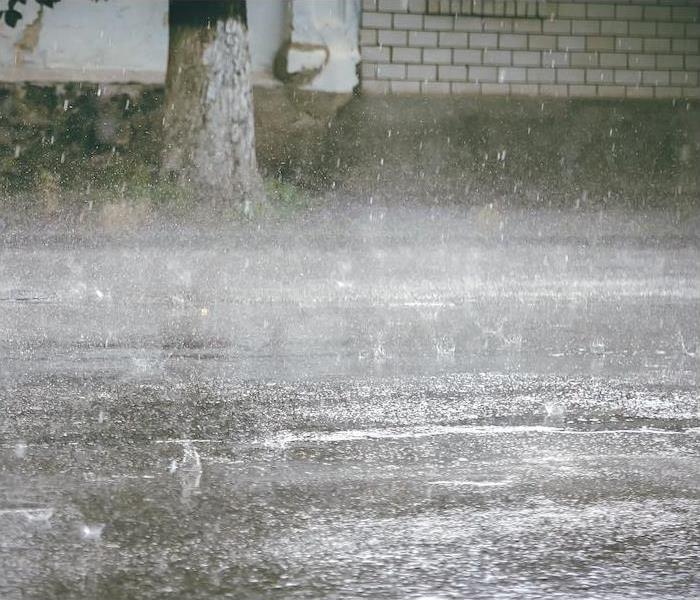 SERVPRO of East Brownsville & South Padre Island is Here to Help® when any disaster strikes!
SERVPRO of East Brownsville & South Padre Island is Here to Help® when any disaster strikes!
Have you ever found yourself wondering when the streak of bad luck will end? It seems like one minor occurrence can lead to so many more, leaving you feeling like the rainy days will never end.
This is particularly true when disaster strikes. Even a small disaster can take weeks to recover from, and one kind of damage will almost always lead to another. Whether a disaster affects only your home or our entire community, fast recovery is something we all need and deserve when heavy rains settle into our lives.
This is why having a total restoration company right around the corner is crucial. With one call to SERVPRO®, we can get things put back together fast no matter what you face.
The Impact of DisastersThe impact of a disaster striking is really immeasurable. Even when a natural disaster is predicted with plenty of time to prepare, it can hit harder and faster than anyone ever anticipated. A disaster that stems from manmade causes can be equally devastating, particularly when things happen completely out of the blue.
A single rain storm that gets heavy can cause a flash flood that can later lead to mold growth. Winds can blow a tree down onto your roof, or take out the power long-term. Fires in your home can leave behind smoke, soot, water damage and intense odors.
Disasters are the very definition of the well-known cliche “when it rains, it pours” as damages will always compound. The longer any kind of damage sticks around, the worse things will get as well.
The physical toll of a disaster striking isn’t the only kind that will settle into your lives either. The mental toll of a disaster can be one of the most challenging ones to deal with, which is why fast recovery is crucial.
A Single Team, Total RestorationWhen something happens to your home or your town, timing will always matter. Our team is always ready, 365 days a year, 24⁄7. From the moment you dial our number, we will start your recovery process as we gather information and put together a team to head your way.
SERVPRO’s staff is trained and certified in a number of disaster scenarios. Not only do we come with highly-trained professionals, we are also well experienced. Our office is locally owned and operated, which means we have experienced the same disasters you have, and we have cleaned many of the homes and offices right here at home.
If a storm blows through town and causes damage to your roof, we can respond around the clock to get it tarped and protected from further damage. If a flood sweeps through town or just your own home, we will start removing water while we simultaneously work to save as much of your personal property as possible.
When a section of your home is damaged beyond repair, we can rebuild it. We make it our goal to get your life put back together, and whatever it takes to meet that goal is exactly what we will do.
Because our team is a total restoration team, we never walk away until you are completely happy with the final product. If your home doesn’t smell like it should after a fire left things charred or mold spread rapidly, we will keep working until it does.
A highly trained staff, top-of-the-line equipment and nonstop availability means that SERVPRO is the only call you will have to make when a rainy season of your life sets in. We will have you believing in sunshine again before you know it.
Have you experienced a disaster and need restorations? Make one call to our office to start recovery fast.
Moisture and Your Home | SERVPRO of East Brownsville & South Padre Island
1/2/2024 (Permalink)
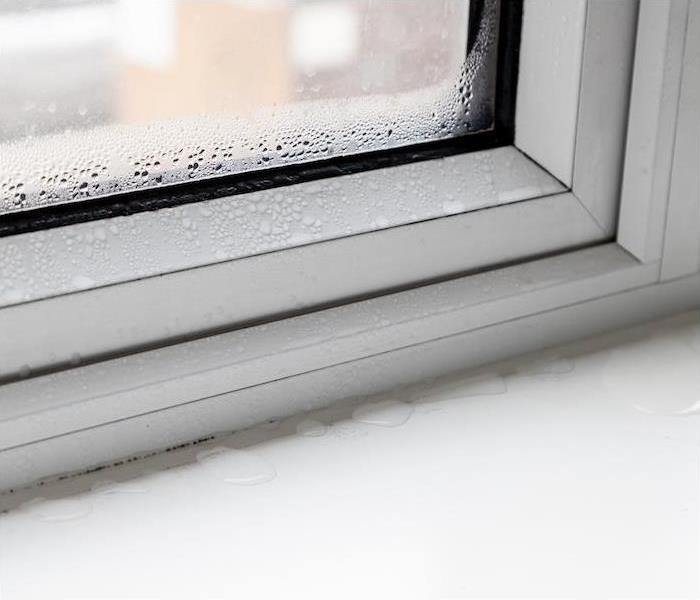 Water damage can happen anywhere in your home. Call SERVPRO of East Brownsville & South Padre Island to restore water damage on your property anytime.
Water damage can happen anywhere in your home. Call SERVPRO of East Brownsville & South Padre Island to restore water damage on your property anytime.
We use water a lot in our daily lives. From running the dishwasher to putting in what feels like the 15th load of laundry for the day, having water the moment we need it is a pretty big blessing. While it is a blessing, when water gets into the wrong places, it can turn our homes on end and create total chaos.
When you know where to look for leaks, you can take fast action to stop them. There are several places that leaks can commonly hide out around your home, but with a little regular maintenance you can keep water exactly where it is supposed to be.
Under Your SinksYour sinks, toilets and bathtubs are all prime places for water leaks to hide. With so many different water lines under each of your sinks and so much water already around, it can be hard to catch small problems before they become a big issue.
When leaks start under your sink, they can quickly affect your cabinets, walls or even the floor. Look under the sinks once a week. Feel the water lines for excess moisture, and tighten the connectors. Replace any seals that have worn out, and dry up any drips you see.
Beneath AppliancesOur appliances really make our lives convenient, but until something goes wrong, we don’t often think about the amount of water that goes in and out of them each time they run. Dishwashers, water heaters, washing machines and refrigerators are all prone to leaks that are often hard to find.
Pull these appliances away from the wall every few months and give the space behind them a good cleaning. Check for puddles, drips or other moisture on the wall or floor. Mold, musty smells or soft spots in the floor are other indicators that something is leaking somewhere in the appliances lines.
Behind Your Walls or FloorsHidden leaks can be particularly dangerous because they can seep into every nook and cranny near them. This often leads to water damage behind your walls and under your floor. Even when you find a leak fast, water may have gotten into the wrong places.
Never ignore a musty smell especially when it is near a water-based appliance. A new squeak in the floor can be another indicator that something is going wrong. Do some investigating so that you can correct issues fast.
Around Your Windows and DoorsCondensation on your windows can be common, particularly when the temperatures are fluctuating. It can be easy to ignore this as something that will go away on its own, but it can actually lead to damage around the structure of your home as the water trickles down into cracks or between your siding.
Check your window seals and around the frames of your windows regularly by feeling for moisture. Feel around your door seals as well. The seasonal change is the perfect time to refresh the seals around your home and keep everything tight.
If you do find water damage in your home, don’t let it cause you to panic. Call SERVPRO® for fast and complete restoration. We have the crew and equipment to get your home dry after a major flood or a little leak that got out of control. Whatever you need, we have your needs covered.
Don’t ignore signs of water damage! Call SERVPRO for a quick restoration.
When Water Takes a Stand in Your Business | SERVPRO of East Brownsville & South Padre Island
12/1/2023 (Permalink)
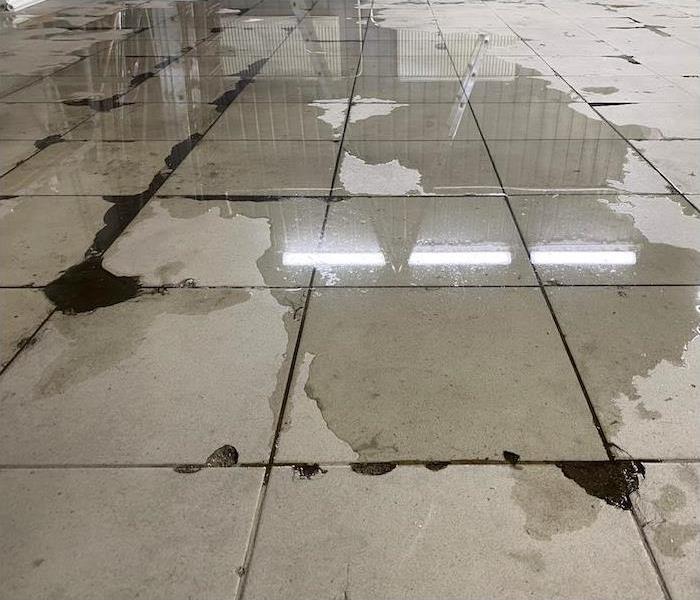 Has water damage infiltrated your business? Give SERVPRO of East Brownsville & South Padre Island a call to get that resolved!
Has water damage infiltrated your business? Give SERVPRO of East Brownsville & South Padre Island a call to get that resolved!
What would you do if you stepped into the office for the day only to be greeted with a musty odor? It would certainly change your morning as you spend time searching for potential water leaks.
While that is not a scenario any of us ever want to face, opening the doors to our commercial building and finding yourself ankle-deep in water would be even worse—a true nightmare that could leave anyone overwhelmed!
Whatever has happened, plumbing failure or a natural disaster, the faster you can move when it comes to water damage, the more you can mitigate your losses. Get to know how to handle finding standing water in your business so you can take quick action and get back to business as normal.
One Step at a TimeThe best way to handle a stressful situation like a flooded business is to break it down to a few simple steps. Give yourself a second to breathe, and then start working toward putting everything back together. Getting started as quickly as possible can prevent future damage and potential mold growth.
1. Safety first. Any time a disaster strikes, regardless of its source, safety should be your first priority. Find the driest place possible, and call SERVPRO® right away. While we gather your information and prepare a team for your property, snap some photos of the water and damage.
2. Find control. If water is still actively flowing, it is important to find its source. Turning water off at the source is the best way to mitigate extreme damage. If you can’t find a specific leak, but have determined it is an internal issue, cut the water to the building off at the main water valve.
3. Begin drying out. Floodwater, even when it is from a natural or clean source, can become contaminated quickly. The more you can stay out of the water, the safer you will stay—but you still want to do what you can to start the drying process. Open windows around the flooded area, turn on fans if you still have power and move anything in the path of the water.
Work With the ProsOnce our team arrives at your property, we will begin removing the water from your building immediately. Our crew will also perform a total assessment so they can walk you through exactly what your recovery process will look like. We will work directly with your insurance agency as well, making sure everything is handled as easily as possible.
As we get moving on your recovery, you can turn your attention to getting back to work. If our team deems it safe to do so, they will contain the area needing restoration so you can operate out of the rest of your building.
While you get your staff back to work, our staff will continue drying everything out. It is our goal to restore rather than replace your belongings. We will work with you to make the best decisions for your building so that things are as close to normal as possible.
Take a stand against standing water in your commercial building. Move fast, and get in touch with our professionals. We will get you back to work before you know it.
Do you need repairs after a water disaster in your commercial building? Contact us to get dried out quickly.
What to Do When Water Invades Your Home | SERVPRO of East Brownsville & South Padre Island
9/19/2023 (Permalink)
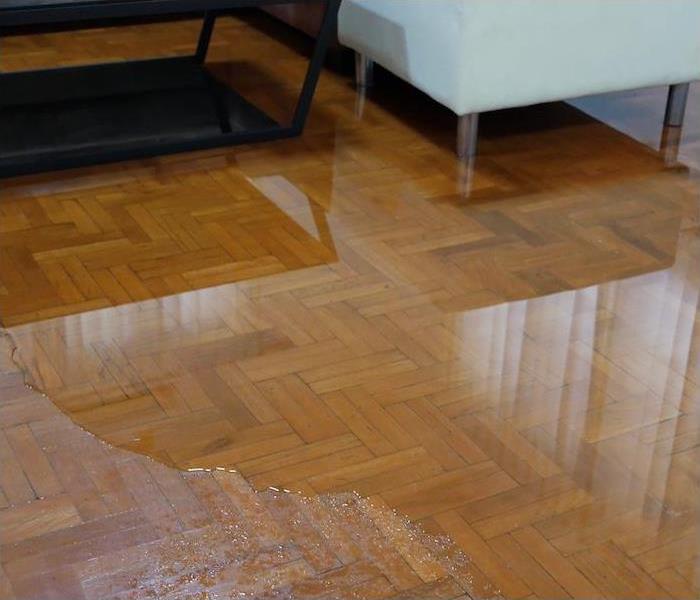 If you discover water damage in your home or business, call SERVPRO of East Brownsville & South Padre Island right away.
If you discover water damage in your home or business, call SERVPRO of East Brownsville & South Padre Island right away.
You may not think about it much, but water is an incredibly powerful thing, even when it is in the most controlled sense. We pump water through pipes in our home and turn it on and off as we will, but even then the pressure can be surprising. If you have ever visited the ocean and allowed it to wash over your toes you know first hand the forceful nature water has.
Water may be necessary for life, but when it creeps into places it doesn’t belong, it can leave behind a total disaster. Between heavy rains, hurricanes and thunderstorms, our Texas home is incredibly flood-prone. Even the occasional tornado has pushed coastal waters in and created flash flooding. Whether from external forces or internal forces, water in your home can be utter chaos.
There are lots of ways to prepare for flooding in order to protect your property, but some disasters simply cannot be avoided. That’s why having water damage restoration experts in your community is crucial.
The First StepsPreparation and protection before a disaster can save you a lot of losses in the long run, but knowing how to respond when your home does suffer water damage can go a long way in preventing extensive damages as well. When it comes to water, the quicker you can stop it, the better your chances of limiting damage will be.
Locate the source of the water invasion and consider what you can do to stop or reroute the flow. If your home is flooding during a storm, you might not have any other choice but to wait it out in a safe location. Internal sources can be shut off, however, so learn all the water valve locations throughout your home. Make sure you know where your circuit breaker box is as well.
Don’t set foot into water that may contain live electrical wires or equipment. Turn the power off first, even if it means killing the power to your whole house.
Once it is safe, call SERVPRO®. Our experts are available 24⁄7, so the time of day when your home is damaged will never make a difference. Actually, it is much better to call us right away so that we can start your restoration process as quickly as possible.
How We Dry Your HomeWe start your recovery process immediately by gathering as much information as possible over the phone. This is a great time to snap some photos of the water and anything it may have damaged. Pictures are a great way to document the timeline and report to your insurance. We work directly with your insurance company so that your restoration process is as easy as it can be.
Our team will head out to your home with equipment designed to thoroughly dry our your property. Removing water and drying soft objects is one of our first priorities in order to salvage as much as we can. Our experts make it their goal to restore everything possible, which means you won’t have to replace the things you love. We can dry your items completely, ensuring they are sanitary and free of odors in the process.
The experts at our locally owned SERVPRO are ready to tackle anything your restoration project will bring, no matter where the water that damaged your home came from. If there is a part of your house that is too damaged to restore, we can tear it down and rebuild it so your home is better than new when everything is complete.
Never try to tackle more than an inch of water on your own. Call in professionals who are trained to handle pipe failures, stormwater and even sewage issues in the safest and most sanitary ways. With SERVPRO right around the corner from your home, you can get back to marveling at the incredibly powerful natural wonder water is without fear of disaster.
Do you have water damage in your home? Call us for fast and complete restoration.
It’s Raining Inside! | SERVPRO of East Brownsville & South Padre Island
9/19/2023 (Permalink)
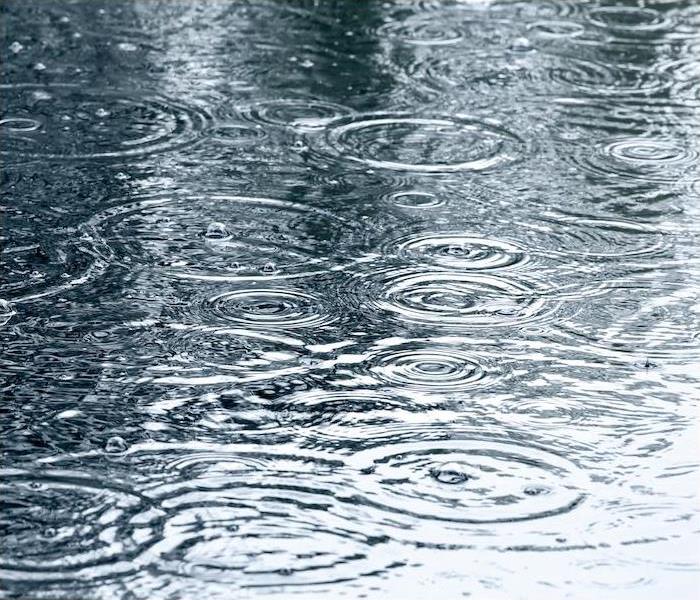 Water damage in your home? Not for long with SERVPRO of East Brownsville & South Padre Island on the case!
Water damage in your home? Not for long with SERVPRO of East Brownsville & South Padre Island on the case!
Rain can be a wonderful gift. When it’s falling at the end of a hot day, leaving the flowers watered and the earth smelling sweet, it is a welcomed sight.
When rain gets heavy, though, it can threaten our homes and leave our yards saturated. Heavy rains often come with other threats, too, including strong winds and hail that could cause further damage. When the rain falls heavy and fast enough, our roofs, gutters and drainage systems can become overwhelmed, leaving us scrambling to dry up as it starts raining inside.
At SERVPRO of East Brownsville & South Padre Island, we want you to know that we are here for you when rain gets out of control. With 24⁄7 service just around the corner, we are ready to dry your home out and help you learn how to keep it dry through every storm.
Hazards of Intense RainOur Texas weather brings a lot of ups and downs. We may not experience the deep chill of winter, but our summers often bring intense heat and strong thunderstorms. Hurricanes, tropical storms and tornadoes also cannot be ruled out.
When hurricanes and tropical storms have blown in, we have seen coastal flooding, but heavy rains and thunderstorms have also brought flash flooding that covered our roads, invaded our homes and left everything soggy. When a storm gets intense and water starts to rise, the ground around our homes becomes overwhelmed and water can start seeping in through the bottom floor while rain can also start dripping through the roof.
With such volatile weather in Brownsville and the surrounding area, we know that preparations are the best way to prevent as much damage as possible. It is important to always have two ways to receive weather alerts from local news authorities and to have a solid emergency plan in place, especially if an evacuation order is placed.
Staying SafeSafety should always take priority when it comes to preparing your home and your family. If a storm is predicted to hit while you are away from home, give everyone a call and have them gather in a safe space as they are able. Bring inside any loose objects, and park your car in a safe space.
Ahead of storms, move items that are irreplaceable to higher levels of your home, and store important paperwork in a watertight container. Most importantly, do your best to stay calm. If water starts coming into your home, move up as high as you can and stay out of the water. As the threat begins to ease, be careful stepping into water that could have live electricity. Call us as soon as you are able so we can start the drying process quickly.
Future Prevention StrategiesYou can’t prevent every disaster, even with the best preparations. If a disaster strikes in your home, it is important to first keep everyone safe, and then to dry things out as quickly as possible. Once you are on the road to recovery, it is a good time to look at how you can make changes to avoid another disaster in the future.
If your landscaping was washed out in the flood, consider bringing in a professional to help add grading and organic material in order to keep water flowing away from your home. Organic material will help with absorption when rain is falling fast as well as in order to prevent ponding that could affect your structure.
If you have a basement or crawl space, a sump pump could be a great upgrade to prevent flooding. Sump pumps are designed to push water away from the foundation of your home as it tries to come in. This can be a great way to keep your home dry.
At SERVPRO®, we have the equipment and expertise to take care of your home no matter how bad flooding gets. We will get your home dry, sanitized and mold-free fast so that you can get back to living.
We are here for all of your water disasters. Contact us day or night for a quick recovery.
Water Damage Lurking in Your House | SERVPRO® of East Brownsville & South Padre Island
5/9/2023 (Permalink)
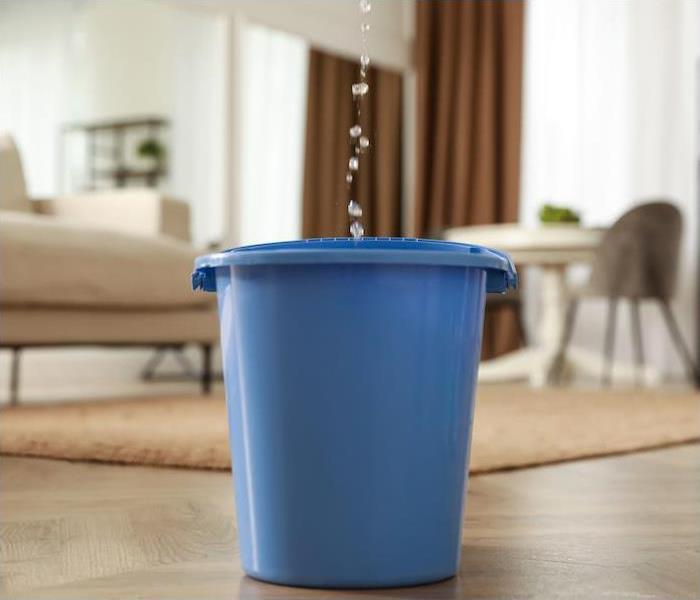 Think you may have water damage in your home? Here are some tips from SERVPRO of East Brownsville & South Padre Island to find the source.
Think you may have water damage in your home? Here are some tips from SERVPRO of East Brownsville & South Padre Island to find the source.
Water is a crucial part of our lives, but when it sneaks into the wrong places, it can create complete chaos. Water damage can become devastating quickly, especially when it starts in hidden places. It isn’t just the water you have to worry about, but over time, you could also end up with mold growth.
If you get to know where water is most likely to hide in your home you can take steps to prevent it, or at least stop it quickly to prevent extensive damages. Get to know a few key areas in your home, and start maintaining them regularly to avoid costly repairs later.
The roof. Your roof is a particularly tricky area when it comes to water damage. With lots of small spaces for water to hide, damage can settle into every floor of your home.
Use our Texas weather to your advantage and take an early warm day to check your roof each spring. You should also try and check it after any strong windstorm, and before a predicted hurricane.
If you can’t get on the roof, check your attic for signs of moisture. Mold can grow and spread in this dark space, so watch for leaks or wet insulation and fix them quickly.
In the bathroom. It might not be surprising that the bathroom is a hot spot for moisture and water damage, but finding leaks can be challenging in a space where so much water is used regularly.
Look under the sink for puddles or dripping noises. Feel around the base of the toilet and shower weekly, and add caulking when it is worn-down. Your bathroom should dry out completely in between uses, so take notice if there is excess moisture hanging around or if your drains are running slow. These are indicators of a bigger issue.
Make sure you are keeping a close eye on the bathroom at least weekly to head off issues before they cause damage.
Large appliances. Anything that uses water can leak water. This includes some appliances you likely use on a daily basis, including you refrigerator, dishwasher and washing machine.
Leaks in these appliances can be hidden underneath or behind them, so make it a point to pull them out once or twice a year. Watch for soft spots in the floor near them and check for the presence of mold under and around them.
Every appliance has a different lifespan and maintenance requirements, but you should consider replacing anything that is more than 10 years old. This can stop problems before they ever start and make sure you have the latest safety equipment in your home.
If you do spot a problem, contact SERVPRO of East Brownsville & South Padre Island right away. We have the tools and expertise to tackle any water damage you experience, 24/7.
Dealing with a water emergency? Our SERVPRO specialists can be on the scene of the disaster ASAP to restore your water-damaged home!
Water Damage Lurking in Your House | SERVPRO® of East Brownsville & South Padre Island
5/4/2023 (Permalink)
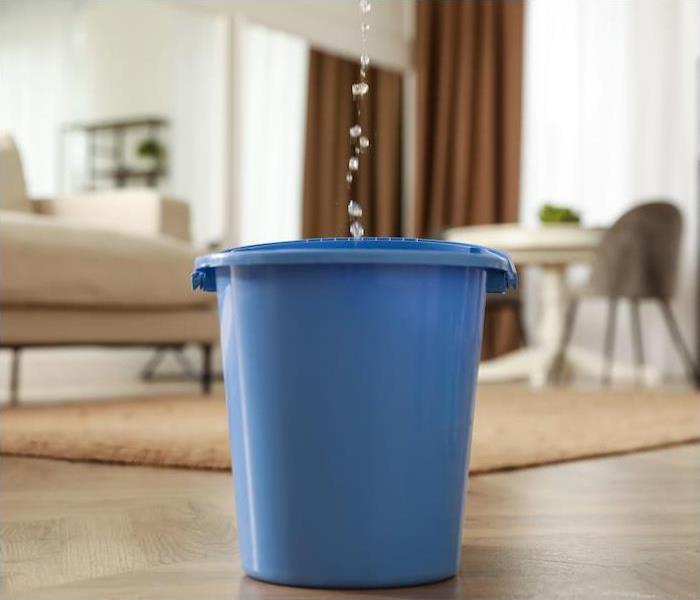 Think you may have water damage in your home? Here are some tips from SERVPRO of East Brownsville & South Padre Island to find the source.
Think you may have water damage in your home? Here are some tips from SERVPRO of East Brownsville & South Padre Island to find the source.
Water is a crucial part of our lives, but when it sneaks into the wrong places, it can create complete chaos. Water damage can become devastating quickly, especially when it starts in hidden places. It isn’t just the water you have to worry about, but over time, you could also end up with mold growth.
If you get to know where water is most likely to hide in your home you can take steps to prevent it, or at least stop it quickly to prevent extensive damages. Get to know a few key areas in your home, and start maintaining them regularly to avoid costly repairs later.
The roof. Your roof is a particularly tricky area when it comes to water damage. With lots of small spaces for water to hide, damage can settle into every floor of your home.
Use our Texas weather to your advantage and take an early warm day to check your roof each spring. You should also try and check it after any strong windstorm, and before a predicted hurricane.
If you can’t get on the roof, check your attic for signs of moisture. Mold can grow and spread in this dark space, so watch for leaks or wet insulation and fix them quickly.
In the bathroom. It might not be surprising that the bathroom is a hot spot for moisture and water damage, but finding leaks can be challenging in a space where so much water is used regularly.
Look under the sink for puddles or dripping noises. Feel around the base of the toilet and shower weekly, and add caulking when it is worn-down. Your bathroom should dry out completely in between uses, so take notice if there is excess moisture hanging around or if your drains are running slow. These are indicators of a bigger issue.
Make sure you are keeping a close eye on the bathroom at least weekly to head off issues before they cause damage.
Large appliances. Anything that uses water can leak water. This includes some appliances you likely use on a daily basis, including you refrigerator, dishwasher and washing machine.
Leaks in these appliances can be hidden underneath or behind them, so make it a point to pull them out once or twice a year. Watch for soft spots in the floor near them and check for the presence of mold under and around them.
Every appliance has a different lifespan and maintenance requirements, but you should consider replacing anything that is more than 10 years old. This can stop problems before they ever start and make sure you have the latest safety equipment in your home.
If you do spot a problem, contact SERVPRO of East Brownsville & South Padre Island right away. We have the tools and expertise to tackle any water damage you experience, 24/7.
Dealing with a water emergency? Our SERVPRO specialists can be on the scene of the disaster ASAP to restore your water-damaged home!
Top Tips for Water Damage Repair
7/12/2022 (Permalink)
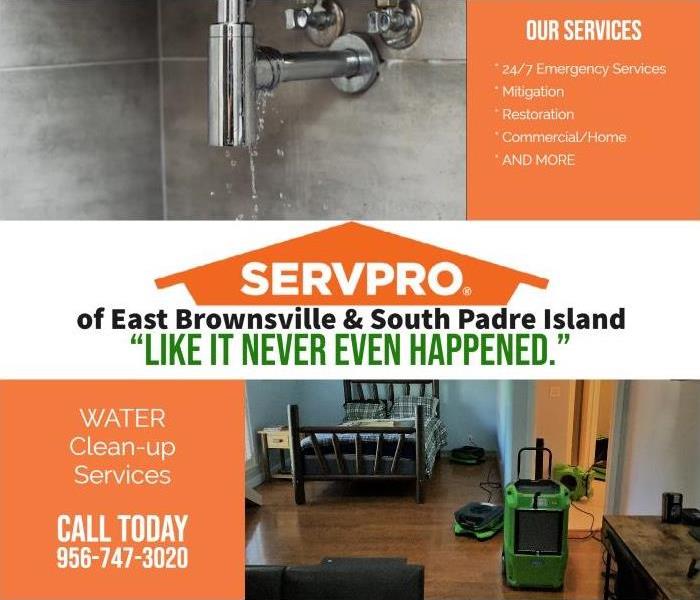 Have Water or Flood Damage?
Call Us 24/7 – (956) 747-3020 for more information on our available services!
Have Water or Flood Damage?
Call Us 24/7 – (956) 747-3020 for more information on our available services!
Unfortunately, it’s not always possible to prevent water damage. Emergencies happen when you least expect them, and more often than not, water comes in gallons instead of drips. When water damage occurs in your home, it’s important to act quickly and take protective measures to ensure everyone remains safe. Use these tips to avoid additional damage, clean & disinfect, & safely rebuild damaged areas.
Take Safety Precautions Against Water Damage
When water is flooding your home, all your impulses are likely screaming to remove the water as quickly as possible. While this is a good idea, you need to make sure the area is safe first. Begin by locating the main water supply to your home and shut it off. Before entering a flooded area in your home, turn off electricity to the area as well.
Now that you’ve addressed incoming water and the threat of electric shock, it’s time for one more potential safety concern.
What type of water is flooding your home? There are three types of floodwaters.
- Clean Water
- This water comes from rain, condensation, or leaky pipes. It has no outside contamination which makes it safe to remove and clean yourself.
- Gray Water
- Floodwater that can be described as slightly dirty comes from appliances like dishwashers, washing machines, and even clean toilets. Gray water is also safe to clean as long as you use proper safety gear.
- Black Water
- The worst type of floodwater is black water which can be contaminated with sewage, bacteria, or other dangerous substances. This water comes from sewage or serious flooding by nearby rivers or other bodies of water. However, it is not safe to remove and clean black water yourself. Thus, contact a professional service with a good reputation.
When your Brownsville home has been affected by water damage from flooding or even pipe leaks, don't worry, we have the expertise, and equipment to properly restore your property. The water removal and water cleanup process are completed by our highly-trained technicians who will document the drying process daily. By doing so, this validates that your property has been dried thoroughly and properly.
Remember, every water loss is different but it is no challenge for our techs or our highly advanced equipment. We have seen it all and done it all and can make any damage "Like it never even happened."
What to Consider Before Water Damage Restoration?
7/11/2022 (Permalink)
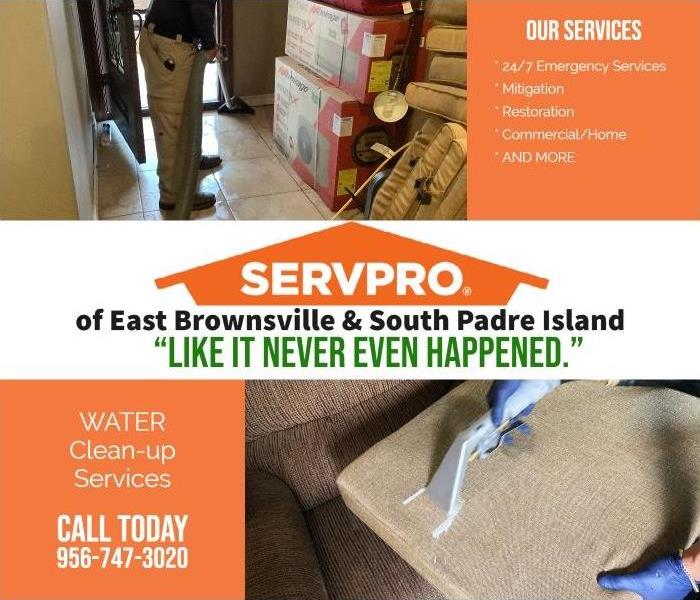 CALL 956-747-3020 to schedule your inspection today!
CALL 956-747-3020 to schedule your inspection today!
How can you determine if you can clean up your home/commercial water damage yourself or is it time to hire a professional mitigation and restoration team?
The first thing you want to do is to evaluate the situation and consider a few of the following factors:
Water Volume
If your home is experiencing a small or moderate amount of water, you can typically manage it on your own if you have the proper tools. However, if there is significant flooding that is not going away despite your efforts, it might be best to call a professional.
If your neighborhood is recovering from a natural disaster or large flood, and your home has suffered significant damage, it may not be the time for a DIY project. Follow the instructions from your local disaster relief authorities and leave these repairs to the experts.
Source of Damage
Before you dive into water damage restoration, you need to discover where the water is coming from. There are three types of water you need to look out for when you have a flooding issue in your home.
- Clean water
- From rain or leaky pipes, this water does not contain harmful chemicals and is safe to handle yourself.
- Gray water
- Leaking from appliances like your dishwasher, toilet, or washing machine gray water may be slightly contaminated. With the proper precautions, you can clean this yourself.
- Blackwater
- The most harmful type of water, blackwater comes from the sewer or flooding from a nearby water source such as a river. It often contains health hazards and is unsafe to handle.
Damage Level
Lastly, you’ll want to assess the level of damage. Light damage can often be handled by the homeowner; however, significant damage can be hazardous and dangerous to repair without the help of a professional. For example, if flooding on an upper level has seeped through the floor onto the ceiling, the damage is beyond your ability to safely restore.
As leaders in the water damage industry, SERVPRO of East Brownsville & South Padre Island are advanced in training and expertise, not to mention a tremendous amount of hands-on experience. We use this training and experience to quickly dry your home and restore it back to pre-water-damage condition. Our process includes documentation of the drying process to validate your property is dry.
Water Damages 411
7/6/2022 (Permalink)
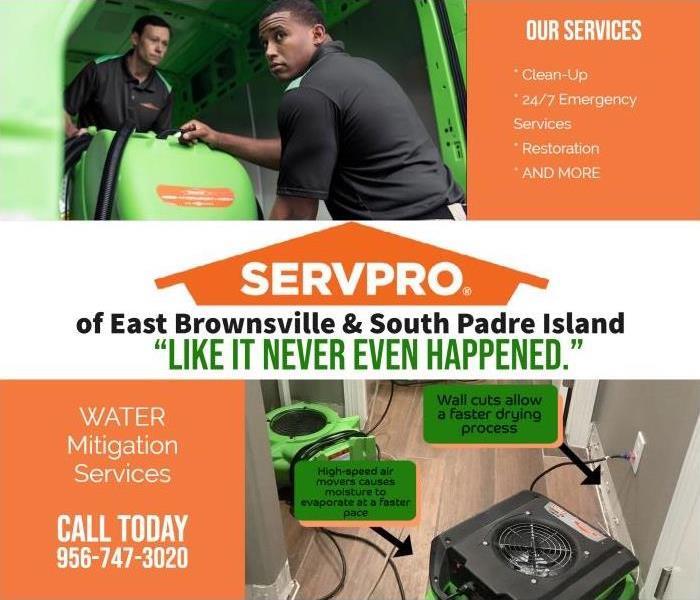 For more information on our available services call 956-747-3020
For more information on our available services call 956-747-3020
That dripping faucet or small water spot may not seem like a big deal, but never underestimate how much damage water can do. In a year, the average household leak can lose up to 10,000 gallons of water.
Water moves quickly and causes destruction to floors, walls and other soft surfaces in its path. When an issue is addressed right away the damage done is greatly lessened.
In the First 24 Hours
Every household has a one in four chance of experiencing flood damage within 30 years of living in a high-risk area. Knowing what to do the moment you spot water is crucial.
The first 24 to 48 hours after flooding or any other water damage occurs are essential. Some belongings will begin to take on water and its ruinous effects immediately.
Upholstery and furnishings with soft surfaces will become saturated, while wooden structures will swell as they take on moisture. Books and photographs are vulnerable to warping beyond recognition. Additionally, mold will begin to form during this time. The faster action is taken the better the results will be.
At SERVPRO, our mentality and expertise are to “restore vs. replace” so that we can protect your most precious items and save you money at the same time. If any damaged items cannot be restored, we will communicate with you and handle removal as needed in order to continue drying out the rest of your home and materials.
Identifying Potential Water Damage in Your Home | SERVPRO® of East Brownsville & South Padre Island
7/1/2022 (Permalink)
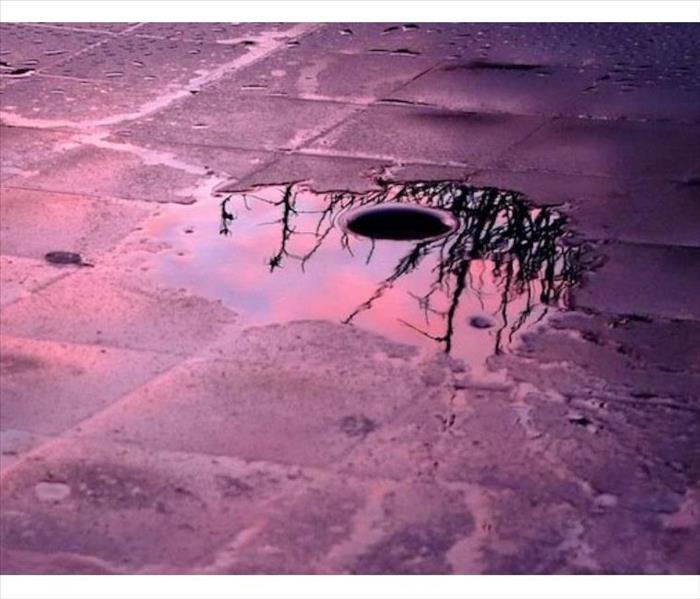 If your home has experienced any water damage, the team at SERVPRO® of East Brownsville & South Padre Island is always available to help 24/7!
If your home has experienced any water damage, the team at SERVPRO® of East Brownsville & South Padre Island is always available to help 24/7!
Severe weather is usually one of the first things that comes to mind for many when they think of the cause of water damage. Storms and flooding can cause catastrophic water damage, but they are often not the main culprits.
Instead, there are many items in your home that can be responsible for situations that result in water damage.
Understanding Water DamageWater damage is something that many homeowners will face, with it being the third most common reason for homeowners to file a homeowners insurance claim between 2011 and 2015, with an average payout per claim of $8,861.
There is a difference between water damage and gradual water damage, which can impact insurance claims. Examples of gradual damage are water line issues that have been happening over time, such as plumbing issues in the walls causing damage to walls, ceilings or floors, or water damage caused by cracks in the foundation. However, the sad truth is that unfortunately many aspects of gradual water damage are not covered by homeowners insurance, while storm-related water damage usually is.
Plumbing Failure and Water DamageAccording to the Insurance Institute for Business & Home Safety (IBHS), here are some of the leading causes of water damage:
Plumbing supply system failures. This involves frozen pipes that can burst because the water pressure builds up due to freezing water in the pipes or when the supply system materials fail, causing pipes to leak or burst. Per the study conducted by IBHS, plumbing supply system failures were the leading source of residential water losses and cost an average of $5,092 per incident after the deductible. They also found that homes with ages of 16 to 40 years made up a larger portion of supply system material failure claims.
Plumbing drain system failures. These occur when sewer drains back up and overflow into a home, or from material performance issues. IBHS found in its study that 52% of drain system failures were caused by sewer backups and 37% were related to material performance issues. They also found that the average southern state drain system failure was more expensive than those that occurred in northern states.
Toilet failures. Toilets cause the second highest number of residential water damage losses after plumbing supply system failures and are the result of faulty fill valves or clogged drain lines. According to IBHS, toilet failures on the first floor of a home created more costly insurance claims than those that occurred in basements or upper floors.
Water heater failures. When a water heater has reached its life expectancy, the tank begins to rust and corrode, resulting in leaking or bursting water line issues. IBHS discovered that 69% of all water heater failures resulted from slow leaks or sudden bursting of water lines and, on average, each incident cost $4,444 following the deductible.
Washing machine failures. These are typically caused by supply hose failures, machine overflows and drain line failures, These situations are one of the top 10 sources of residential water damage losses and, per IBHS, supply hose failures accounted for over half of all washing machine-related losses.
When it rains.. it pours!
6/8/2022 (Permalink)
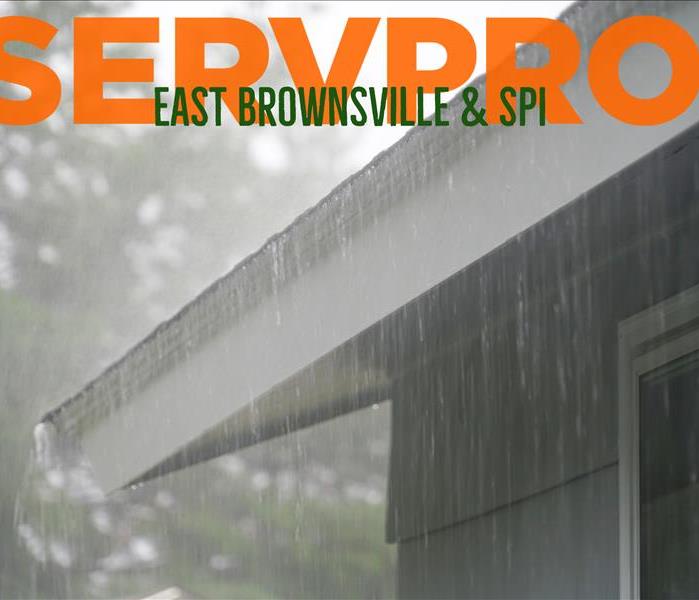 Have any question on our available 24/7 emergency services, Call 956-747-3020
Have any question on our available 24/7 emergency services, Call 956-747-3020
Living in Brownsville/SPI area has taught me 2 things: 1 when the sun’s out you have to go to the beach and 2 when it rains… it pours!
When yourBrownsville or SPIhome/business has been affected by water damage from flooding or even pipe leaks, don't worry, we have the expertise, and equipment to properly restore your property. With 24/7 emergency services available, the choice only gets easier on who to hire!
Remember, every water loss is different but it is no challenge for our techs or our highly advanced equipment. SERVPRO of East Brownsville & South Padre Island, have seen it all and done it all and can make any damage "Like it never even happened."
Insurance FYI’s
11/11/2021 (Permalink)
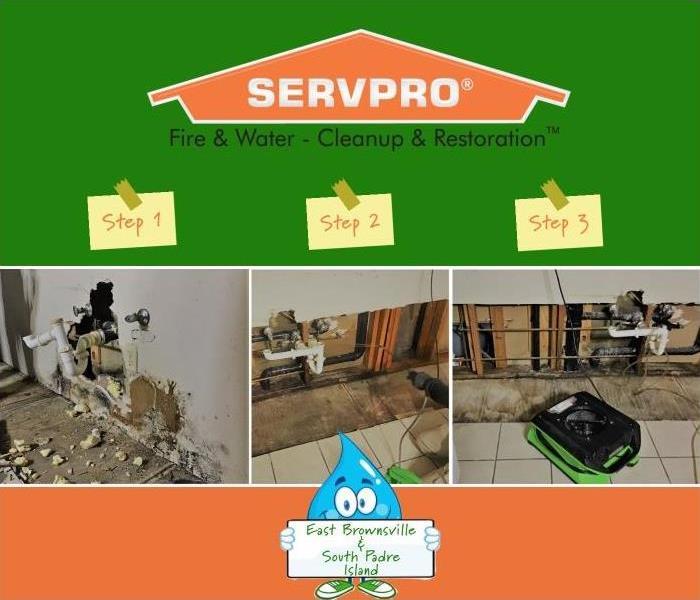 When water damage strikes, a fast response is critical. 24/7 Brownsville residents and business owners can expect us to respond immediately!
When water damage strikes, a fast response is critical. 24/7 Brownsville residents and business owners can expect us to respond immediately!
When a storm is approaching there is a few insurance FIY’s you should be aware about and AFTER the storm too, and we are going to talk about them in the following blog!
FYI before a storm you should know:
- New and existing policies will not be written when a storm nears the gulf.
- Make sure your policy covers additional living expenses for a temporary residence if you are not able to live in your home due to the damages from a disaster
- Be prepared with a detailed written and/or photographic inventory of your homes contents and store in a safe place with your policy
- If your insurance does not cover flood or windstorm perils, ask about coverage through the Texas windstorm insurance association or the national food insurance program
FYI after the storm you should know:
- give prompt written notice to your insurance company
- photograph or video tape damaged structures and property. Make a list of damaged or lost items
- do not throw out damaged property before your adjuster has inspected the debris unless it is a hazard or impedes local cleanup
- keep an accurate record of temporary repair and living expenses if a loss of use is suffered
Every water disaster is different, from the amount of water to the level of contamination of the water. Each scenario requires a unique solution, but the general process stays the same.
SERVPRO franchise professionals have the expertise and highly advanced equipment that allows us to emphasize monitoring and documenting the drying process from beginning to end to properly restore your property to pre-water damage condition with no mistakes at all. Our experience and scientific approach to water removal and water cleanup enable us to properly dry and restore any type of damage water that may have occurred to your home or business.
Know the location of your water main
11/2/2021 (Permalink)
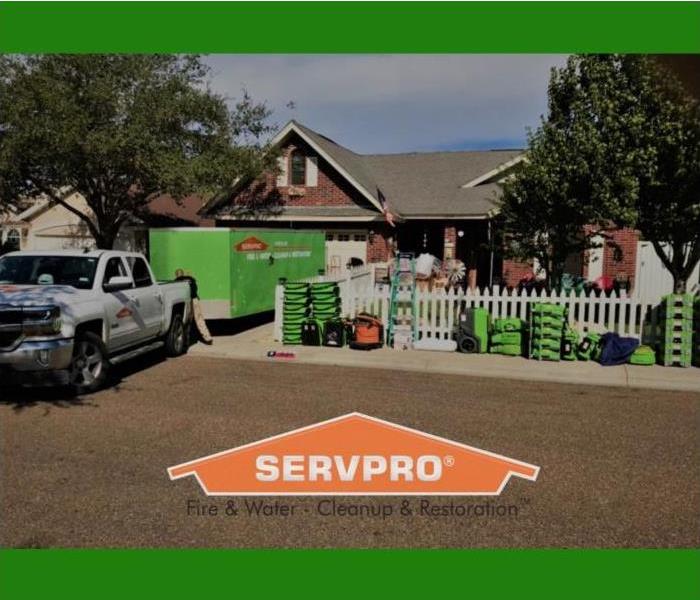 When water damage strikes, a fast response is critical. Day or night, Brownsville residents and business owners can expect us to respond immediately!
When water damage strikes, a fast response is critical. Day or night, Brownsville residents and business owners can expect us to respond immediately!
You’d be surprised at how many home/business owners have no idea where their main is located.
Knowing where your main is located is the first step in prevention or minimizing any water damage disaster.
Sometimes, no matter how much you prepare or implement preventive measures, water damage cause extreme catastrophe either from natural disasters or burst pipes that you have no control over – shutting off water to your house is how you’ll prevent further damage.
This can make the difference in saving time and money, and that’s where we step in.
When your Brownsville home has been affected by water damage from flooding or even pipe leaks, don't worry, we have the expertise, and equipment to properly restore your property.
The water removal and water cleanup process are completed by our highly-trained technicians who will document the drying process daily. By doing so, this validates that your property has been dried thoroughly and properly.
Remember, every water loss is different but it is no challenge for our techs or our highly advanced equipment. We have seen it all and done it all and can make any damage "Like it never even happened."
Have Water or Flood Damage?
Call Us Today – (956) 747-3020
Water damage vs flood damage
7/13/2021 (Permalink)
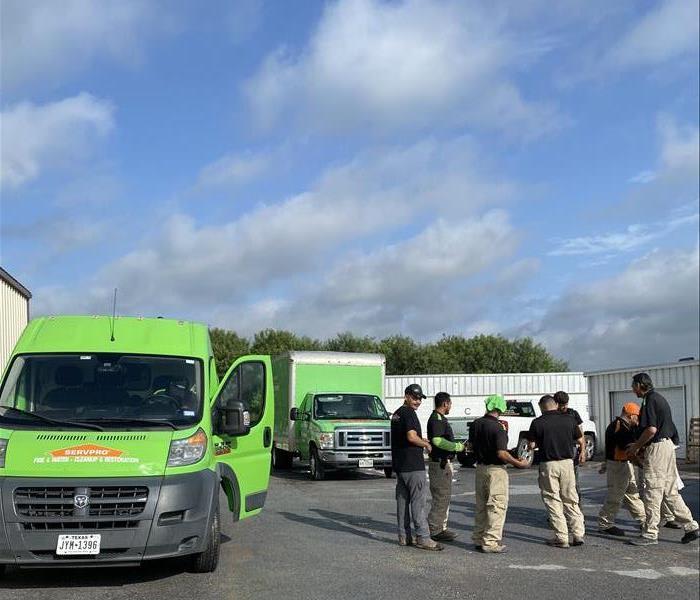 At SERVPRO Brownsville-SPI, we work 1x1 with your insurance provider saving you time and hassle! Just call 956-747-3020 for more info.!
At SERVPRO Brownsville-SPI, we work 1x1 with your insurance provider saving you time and hassle! Just call 956-747-3020 for more info.!
Would you be shocked, to learn today, that flood damage is not considered a form of water damage? “What?” “How?” or “Why?” are probably all the questions going through your head right now. You’re not alone though.
Homeowners/business owners sometimes don’t know or realize that water damage and flood damage are 2 different kinds of coverages. It’s important to know that if you own a home but do not have flood insurance, you will not be compensated by your insurance company for flood damage.
We’re going to break down some components for you here and explain some causes and key items your insurance WONT cover in the event of either flood or water damage.
Water Damage:
Potentially covered by homeowner’s insurance. Affects only your home.
- Common causes:
- appliances, busted/frozen/leaking pipes, bathtub/toilet overflow
- Key items not covered:
- Repair of the source of the leak (i.e. washing machine)
- Flood damage
Flood Damage:
Potentially covered by flood insurance. Rising water OUTSIDE the home as well. You and your neighbors where effected (2 or more properties)
- Common causes:
- Body of water overflow
- Heavy constant rain
- Key items not covered:
- Outside Property (trees, fences)
- Vehicles
Get in contact with your insurance to get a personal breakdown, if you’re facing water damages. They can determine if for your scenario, you’d be covered.
Water Damage: Can wet carpet and dry wall be saved?
7/12/2021 (Permalink)
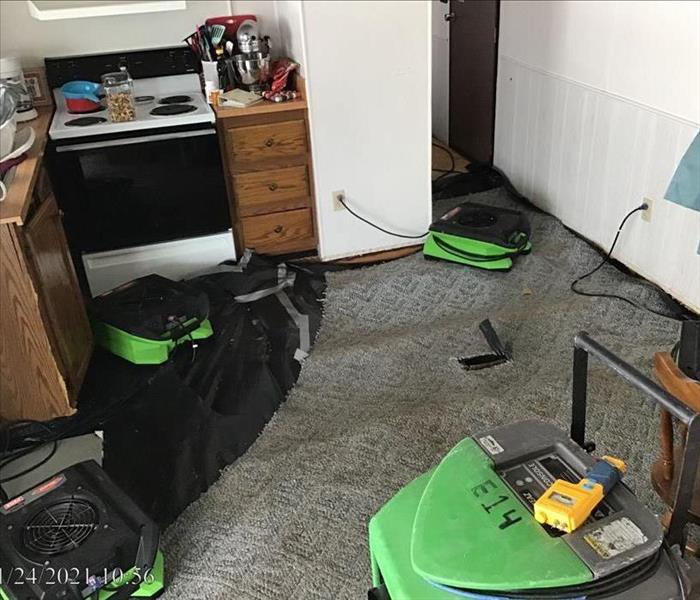 Call 956-747-3020 for more information !
Call 956-747-3020 for more information !
There may be a lot of questions we have when facing a water damage situation, but let’s face it when it comes down to our belongings we want to know, can they be restored. In other words, can they be saved. There are some events in which our walls will become wet as well in this case we may question ourselves, “am I going to have to remove this whole wall”. They aren’t silly questions, they’re actually very common.
Let’s break down some components that may become be ruined if you suffer any interior water damages.
Wet Carpet- Many carpets are made of synthetic fibers, which is what makes our carpets so fluffy and warm. These kinds of carpets are also going to be the ones that suffer the most with water damage. I bet you’re reading this like so yes or no can I keep my carpet or not. Well, it’s going to come down to the source of the water.
- If the flood comes with mud that was caused but a storm and the carpet was soaked for a long period of time, then you might just want to dispose of it
- Now, if the flood was caused by standing water or a broken pipe, then there might be room to save it
Wet Drywall- When building a home, your walls and ceilings are made up of drywall. Dry wall, although may be easy to install and is durable, only requires simple repair when damaged. But what if they get wet? Believe it or not since dry wall is made of porous materials it can absorb water more than wood does. When it’s wet, it may well, swag, now and most of all, it can create the best breeding ground for bacteria and mold. You may need a profession to inspect the dry wall to determine if it needs drying or should simply be replaced.
Call SERVPRO Brownsville/SPI for more information on your personal items and inspection of your home. We can determine if any items can be salvageable and with a team of professionals by our side we can also determine if you will be needing any restorations to your home.
Claiming Insurance 101
7/7/2021 (Permalink)
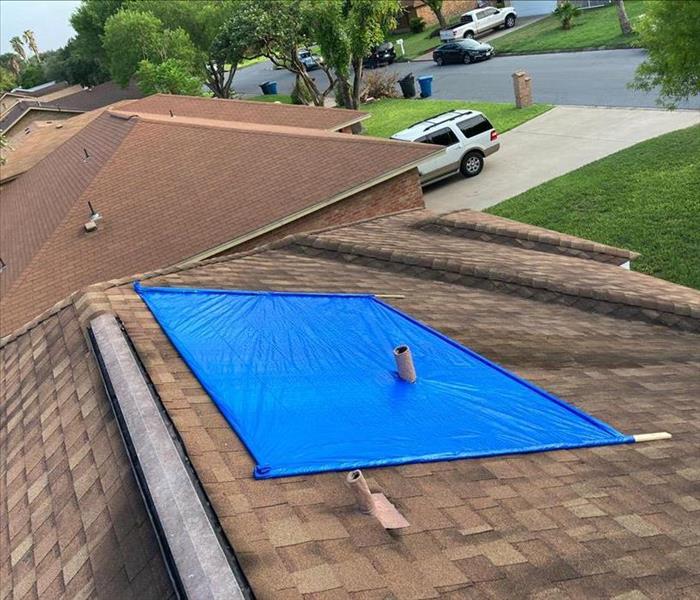 Emergency tarping, installed by our SERVPRO employees.
Emergency tarping, installed by our SERVPRO employees.
After doing some research I learned that according to the ISO, water damage increases every year compared to the damages caused by other things like wind or hail. Now, the tricky part would probably be WHEN the insurance company denies some claims due to specific reasons. That’s is why it is very crucial if you’re a water damage insurance holder, do your research educate yourself on the do and don’t and what you’re covered in.
Moment of truth: How to claim insurance for water damage
- Contact your insurance company ASAP- most companies have specific deadlines to report your claim after you’ve been impacted. Make sure you immediate reach out to then so they can begin to make the necessary arrangements to your claims.
- Make a list of your damaged property- documents everything. Take pictures and videos of any damage caused by the water. This could help you and your insurance to easily determine the cause and effect of the water damage
- Protect your things- some insurance companies may deny claims if they see that some repairs were made before the home was inspected, therefor make only temporary repairs (if necessary).
- Keep receipts- some insurance will give you the ability to repaid before you cite is inspected, so if this is the case be sure you save your receipts in the event your insurance can reimburse you for those fixes.
- Be present- in case your home is found to be damaged have your contractor come with you so he or she can talk to the adjuster about the damage. This may also provide you the help you need to get the maximum amount for the water damages.
- Get a certification if the damages are caused by an appliance leak- the inspector will give you a certificate for the water damage to your cite. Make sure you keep that certificate for your insurance claim. Otherwise, your claim will be denied unless you can show proof of the damage aside from the certificate from the inspector.
Your key guide to identify water damage in your property
7/1/2021 (Permalink)
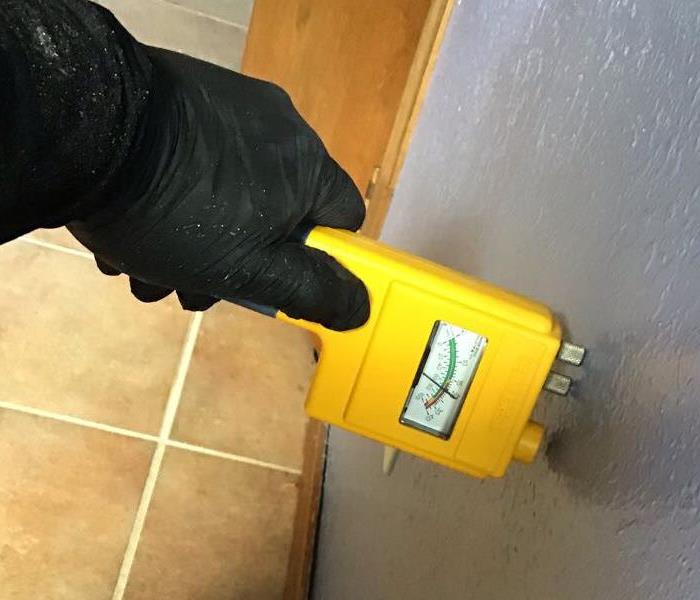 At SERVPRO, we make sure to use all tools necessary to identify any water damage within your walls.
At SERVPRO, we make sure to use all tools necessary to identify any water damage within your walls.
Being aware of the signs pointing you to water damage can help you, as the owner, identify a problem before it’s too late, and reach out to experts.
These are some signs you want look out for:
Unpleasant, musky odors. Water leads to mold and mildew growth, and as the water evaporates and leaves the bacteria behind, a musty odor can develop. A lot of times, this odor is the first thing that homeowners notice when they are experiencing water damage.
Flaking paint on masonry or walls. Water damage can sometimes be temporarily hidden with paint, which is what a lot of home and business owners tend to do. While this may temporarily “solve” the problem, it is not a long-term solution you want to stick too.
NOTE: Water will always find its way in if there is an underlying problem, which can lead to issues with paint over time such as cracks, flakes and chips.
Foundational cracks. As temperatures changes and the ground shifts and settles, it is normal for hairline cracks to develop throughout the home’s foundation. But, any cracks you see larger than a hairline should be immediately examined.
NOTE: Cracks that occur on the ceiling, walls or floor are often signs that water damage is occurring somewhere within the home and leading to damages.
If you notice any of these signs in your home or business, call SERVPRO. Our expert water restoration technicians, available 24/7, can help you determine what is causing these issues and how to treat it properly. Contact us today to learn more
Preventing water damage with SERVPRO
6/30/2021 (Permalink)
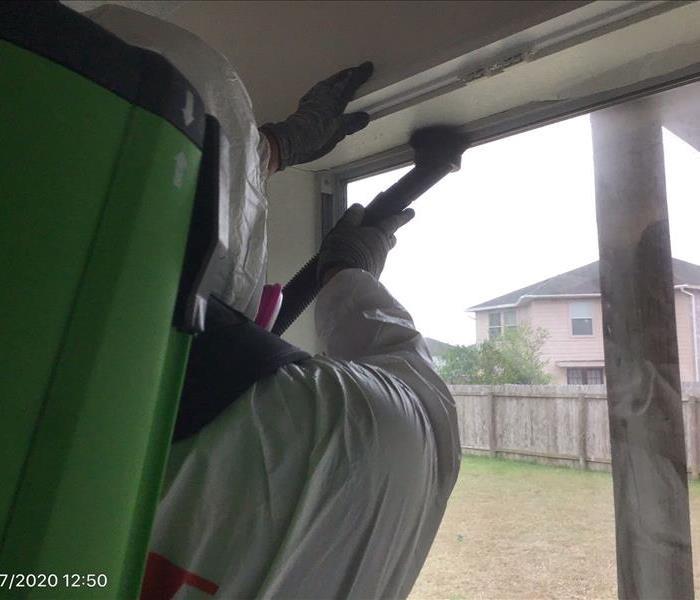 Up close pic of SERVPRO employee hepa vacuuming. This is our first step of our process for mold remediation.
Up close pic of SERVPRO employee hepa vacuuming. This is our first step of our process for mold remediation.
One of the biggest disadvantageous things that can happen to you this summer, is having severe water damage and flooding in your home. From dealing with a broken pipe or a more serious issue, like sewer backup or a flooded basement, they can all lead to bigger complications.
Its import to act fast in the event you are experiencing any water damage. With just a small amount, of water within 24 hours, mold starts forming.
Your first priority is going to be to stop any leakage you have or whatever the source of the problem is. Once you have stopped it from causing any more damage, you may need to contact a professional to start taking the proper water damage restoration steps to repair and restore your home back to normal and prevent additional damage.
Water damage may also result in all sorts of safety hazards and structural problems that you may not even notice until it’s too late. SERVPRO can help in all of these scenarios we work round clock 24/7 to be able to help you and your home “like it never even happened”!! We assure a thorough clean and restore the damage so you may be able to return to your home sweet home!
https://www.SERVPROeastbrownsvillesouthpadreisland.com
Slow Ceiling Leak Causes Water Damage in Brownsville.
11/17/2020 (Permalink)
A slow leak in your Brownsville home can cause more damage than you realize.
It is never a good sign when water spots appear on the ceiling. It is a safe bet there is some level of water damage that has occurred.
In the case of a home in Brownsville, water damage caused by a slow leak in the ceiling accumulated over time until it ruined the sheetrock panels and the taped seams. This resulted in the need for controlled demolition in the form of a partial tear-out of the ceiling down to the raw joists and sheathing so the necessary plumbing repairs could occur.
Purpose of Controlled Demolition
When building materials require removal from the home, SERVPRO technicians cut them cleanly away to make the repairs as fast and easy as possible for both the plumbing and the cosmetic renovations necessary to restore the ceiling to its preloss condition.
Drying the Water Loss Area
To be sure all areas of excessive moisture get attention, SERVPRO technicians use their advanced moisture detection equipment to scope the room and make sure there are no other areas that show elevated water vapor levels. After removal of the damaged sheetrock panels, the technicians use air movers aimed upwards to dry the ceiling and also drying mats above to force warm, dry air downward to ensure the affected area dried completely.
Mold Treatment
SERVPRO technicians found no signs of mold growth, but when a surface has exposure to water over a lengthy period, proactive treatments to avoid mold are a smart course of action. The techs used an antimicrobial sealant on the joists and open area as soon as it was dry to inhibit any mold growth.
Assisting Homeowners After Completion
A standard part of service is ensuring homeowners are happy with the work done. Once the mitigation completes, a technician walks the homeowner through the process and shows them the necessary actions. They also note any necessary repairs needed to restore the home entirely.
When water damage happens to your property, call SERVPRO of East Brownsville & South Padre Island at (956) 747-3020. The certified technicians can clean up and restore the home to its preloss condition, "Like it never even happened."
The Basics of Helping Homeowners Recover From Water Damage
11/4/2020 (Permalink)
Flooding and water-related disasters are widespread. Also, they have caused many property owners quite a headache. And while water damage isn't something that can't be fixed, time and quick response are crucial during a water disaster.
While it’s common for property owners to want to rush the repairs so they can get their house back to its pre-damaged state ASAP, it’s the responsibility of the water damage restoration team to ensure that the entire process is carried out correctly and safely.
Here are some of the most critical points to keep in mind when handling a water damage situation.
Safety should be a priority.
In the event of a crisis, your primary concern should be the safety of everybody involved.
You’re already well aware that water and electricity are a lethal combination. So, it follows that in any flooding situation, the first thing you should do is switch off the electrical power in the flooded area. Afterward, close the main water valve to prevent any contaminants from entering the water system.
Lastly, should you feel the immediate need to wade through the water to check the flooded premises, don't forget to wear waterproof boots and safety gear.
Accurate assessment of the damage is essential.
There’s often more to flooding and water damage than meets the eye, which is why it’s crucial to identify the level of water damage in the area before going further with the mitigation and repair process.
Water damage is categorized into three levels.
Category 1 - water is generally clean, sanitary, and safe for consumption.
Category 2 - microorganism level in the water is too high and has the potential to cause sickness if someone were to ingest or get in contact with it.
Category 3 – water is severely contaminated and contains toxins and pathogens, which could be fatal.
Aside from identifying the level of water damage, a thorough assessment of the affected premises will give you a clearer picture of the extent of damage, and how much the repairs could cost.
Dry out the area properly.
When it's finally safe to enter the area, the next thing to do is get rid of water and moisture before they cause any more damage. However, if it's massive flooding you're dealing with, you'll have to wait for the flood to dissipate before starting the drying process.
For small leaks, you can use a fan to circulate the air and dry out the affected area. For heavier flooding situations, however, you may have to use a hand or electric pump to drain the water and then a large-capacity dehumidifier to ensure that there's very-little-to-no moisture left. When most of the house or the building is dry, open up the windows and let the air circulate. If the heating system still works, turn it up to drive what's left of the moisture and prevent mold growth.
Don’t forget to test for moisture.
With the area almost completely dry, it's time to remove waterlogged items from the affected area and sort them into piles. You can keep the ones that look salvageable and throw those that are beyond saving.
Before commencing work on the structure, though, make sure to run tests on the moisture level of the walls and floors. A moisture meter can help you check if the moisture on the walls and framings have dropped to a suitable level, while a flooring hygrometer is the most reliable tool for testing the dryness of concrete floors.
Carry out remediation and repairs as soon as possible.
Standing water is an ideal breeding place for pathogens and bacteria, while moisture can pave the way for molds to develop. When water damage is concerned, immediate action is necessary.
You see, if the remediation phase is not completed promptly, a category 1 and 2 damage can potentially turn into a category 3; a simple cleanup may turn into an extensive, complicated, and costly job. Time is of the essence when dealing with a water damage situation.
In Case of a Water loss Emergency, Call the Water Damage Professionals at SERVPRO to get the job done right. (956)747-3020
Worried About The Cost of Restoration? SERVPRO Has You Covered
5/11/2020 (Permalink)
SERVPRO works with you and your Insurance company.
Once homeowners get over the initial shock of finding a water leak in their home, most begin to worry about the cost of restoration. How much are the restoration and repairs going to cost? Can their budget afford it? Can they cut any corners? Does their homeowner's insurance cover everything? These and other questions can quickly overwhelm people.
SERVPRO provides water damage services in Brownsville, as well as restoration and repair in all surrounding areas. We have been providing water damage services for many years. Our experience and technical certifications, combined with 24/7 availability and 4-hour response times, are aimed at mitigating the damage and controlling the total cost of recovery. There may be an additional cost and even health effects if homeowners do not take the proper steps to remove all moisture from their homes.
Making Informed Decisions:
One of the first actions our crew chief takes upon arriving at your home is to complete an assessment of the damage. We make sure that the source of the water is under control, and we develop a plan to remove standing water, remove the moisture, and lower the humidity. If repairs are required, these can also be discussed with the homeowner and the insurance company adjuster. We prepare an estimate of the cost to complete all of this work.
Homeowners can quickly decide in conjunction with the insurance adjuster what action should be undertaken. Note that it is essential to act quickly to avoid long term damage to floors such as hardwood floors and also the growth of mold and mildew in your home. SERVPRO can deploy a team of people within hours of the initial leak to mitigate the damage.
Homeowners without insurance coverage must carefully decide what action to take. Delays or taking no action at all can lead to costly damage more significant than the initial cleanup and drying. Hardwood flooring can cup, crown, or crack, leading to total replacement. Cabinet structures may swell, become unsightly, and lose structural integrity. Worst of all, mold infestations may appear, leading to structural damage, health effects, and very unsightly looking conditions. All of these conditions can be much costlier to repair. SERVPRO can help homeowners understand these issues and make appropriate decisions for their situation.
Call SERVPRO of East Brownsville & South Padre Island at (956) 747-3020 for 24/7 service. We proudly serve Brownsville, South Padre Island, and surrounding areas. We're Faster To Any Size Disaster.
Why Standing Water Is A Concern For your Home or Business.
5/11/2020 (Permalink)
Our SERVPRO Professionals Can Help to Remove Standing Water and Dry Your Home or Business Before Irreparable Damage Occurs
Following a flood or substantial water loss that could occur in your house, it is crucial to focus on removing standing water first. As much of a priority as this should be, many homeowners are ill-prepared for this mitigation step. To successfully achieve the removal of standing water in your home, it involves the union of sophisticated extraction tools and experienced restoration technicians.
Water removal involves the use of multiple extraction tools in our inventory. Finding the right tool for a specific job is a determination made during the scoping of the work to get done. During this initial phase that precedes mitigation, our crew chief and project manager can work with the customer to determine pre-existing conditions, the extent of the damage, and the most efficient extraction and drying solutions available.
What Are the Main Risks of Standing Water in My Home?
Standing water is an underappreciated threat to your home. Pooling water, regardless of its depth, can have destructive effects unexposed materials, contents, and other susceptible items. Addressing standing water first can help too limited some of the damaging effects that could take place, including:
Structural Weaknesses
Overexposure to standing water over extended periods can lead to a weakening of construction materials in your home. It is essential to note which materials might be deteriorating and highly saturated after water exposure. Saturation can make materials much more massive, which tests the limitations of fasteners like drywall screws and nails.
Migration
The movement of water throughout your home after a water loss incident can be a challenge to identify adequately. Getting ahead of this migration is vital, as it can limit how many materials and contents in your home become exposed to damage.
Oversaturation
Much like heavier saturations can deteriorate materials like drywall, over saturation of materials like carpeting and wood flooring can lead to specific problems of their own. With prolonged exposure, water can penetrate the surface layer of carpeting, affecting both the padding underneath this layer and even penetrate the subflooring.
Excessive Demolition
It is consistently a priority of our SERVPRO team to limit controlled demolition and later reconstruction of your damaged home. The fast response when the extraction is needed can help to mitigate the water loss event, and prevent unnecessary demolition when possible.
How Can SERVPRO Remove Pooling Water?
As briefly mentioned, the focus of our responding technicians is removing standing water from damaged areas of your home as soon as possible. Our team can go about this in several ways, and it varies based on the severity of the damage, the location of the standing water, and its depth. We have multiple tools to help in this regard, but the most commonly used are:
- Submersible pumps
- Wet vacuums
- Squeegee wands
What Happens to Water-Damaged Items in My House?
Content management is another vital aspect of the immediate work that we can do when we arrive at a water damaged house. By assessing the water damage to your personal propertynv, we can make real-time drying decisions and recovery choices based on what these items need. In many situations, there are upwards of three primary categories the content recovery can fall into, including:
On-Site Relocation
Relocating items in a house to a safer area within the structure can be the most efficient method of protecting your belongings when no other damage is present. This solution is only suitable when no other physical damage is identifiable on the individual items.
Cleaning
Cleaning up individual belongings might seem like a tedious approach, but it can help to reduce out-of-pocket expenses for our customers. By drying and surface cleaning damaged items in the house, we can have items better prepared for replacement in the home following the completion of restoration and mitigation phases.
Off-Site Recovery
In some situations, on-site recovery is not feasible. If more intricate cleaning and restoration are necessary, items can get relocated to our nearby SERVPRO facility for the attention they need.
How Fast is Drying After Water Removal?
While our team has much experience and training in drying sciences, there are too many variables to say with certainty how long drying processes typically take. We must determine where moisture exists and utilize our advanced tools to remove it from the house as quickly as possible. With equipment like high-velocity air movers and positive pressure systems, we can get you back in your home quickly after a loss incident.
Water loss incidents can be a challenge to overcome, even for experienced restoration technicians like our SERVPRO of East Brownsville & South Padre Island professionals. Give us a call anytime that we can help with our sophisticated equipment and experienced technicians. We are ready 24/7 at (956) 747-3020.
Why Choose SERVPRO of East Brownsville & South Padre Island for Your Water Damage Needs?
1/8/2020 (Permalink)
A pipe burst. A water heater leaks. A bathtub overflows. Flood water rushes in. A sprinkler system malfunctions.
Water damage can happen in any number of ways. But if your business or home is under a few inches of water, everything takes a backseat. Only one thing matters when your business can’t operate, and there is just one thing on the mind of the water-logged resident; a solution.
SERVPRO of East Brownsville & South Padre Island is that solution. Equipped with the knowledge, the experience, and the training to help make your water damage “Like it never even happened.” SERVPRO professionals will start helping the moment you call.
Backed by more than 10 years of experience, SERVPRO of East Brownsville & South Padre Island professionals will help put your worries at ease, because they understand the science of drying.
When water damage strikes, give SERVPRO of East Brownsville & South Padre Island a call, we will help to make things right, make things dry and make it “Like it never even happened.”
Call us at (956)747-3020
We Can Handle Your Commercial Water Damage
1/8/2020 (Permalink)
Trust SERVPRO of East Brownsville & South Padre Island for Immediate Water Removal When Your Business Needs Assistance
Commercial water damage can close the doors of a business enterprise. It may be a retail store, a doctor's office, an apartment complex, or even a big-box store. Disruptions to normal business patterns lead to loss of goodwill and revenue. Consider calling in a professional water damage restoration company like SERVPRO to limit your losses.
Brownsville water mitigation professionals are needed when it comes to handling unwanted water intrusion. Water damages can occur at any time and any place. It is important to be prepared to call a professional because water damage can be very hard to clean up by yourself. In fact, water gets into many places that are inaccessible. As a result, even after you have dried up the building yourself, you can still get mold and other problems in the building.
It takes quick action to handle the damage efficiently. You have to make sure that all the belongings are safe. If the water has gotten to some of the belongings, it is important to make sure that you clean them out as quickly as you can before any permanent damage occurs. All of the other items that you can save, you should do so. Afterward, you should contact a professionally certified team that will remove the water and use specialized drying equipment. Our SERVPRO of East Brownsville & South Padre Island professionals are certified and have the equipment needed to take care of the water damage.
SERVPRO of East Brownsville & South Padre Island is a commercial water removal company that has experience in mitigating water damage. We know how to handle water damage that resulted from storms, clogs, natural disasters, and other similar events. We are always available when you call and will promptly dispatch a crew. Call us at (956)747-3020.
Home Water Damage DRAINED By Experts At SERVPRO!
12/18/2019 (Permalink)
Fast Action and Cleanup of Water Damage In Your Home
When damages affect structural components and the contents of your home, you need professionals that can mitigate the crisis and resolve your situation FAST. In a water damage situation, cleanup needs to happen as quickly as possible to prevent ongoing damage and detrimental effects that lead to irreparable damage.
Water loss situations require an immediate response from skilled technicians equipped with the right tools. Our SERVPRO water restoration technicians begin their training with the extensive IICRC-certification, which is the premier standard of the industry. They take part in ongoing in-house and e-learning options to improve their knowledge in essential recovery techniques such as mitigation and drying.
These skilled technicians are available to you for water cleanup, mitigation, and water damage restoration 24 hours a day through our response team. As water damage is time sensitive, having a crew of highly-trained technicians that can mobilize personnel and equipment efficiently reduces the impact that water loss incidents have on your property. Within a matter of minutes, water can absorb into walls, floors, upholstery, and your personal belongings. You need a team that can respond immediately to help.
The equipment we use for water cleanup and restoration work is among the most advanced machines and tools available in the industry. We seek to have the best equipment possible, as this ensures that we can provide fast extractions, drying, and premier cleaning solutions. Drying is an important step in water restoration, and our high-powered equipment can detect moisture so that we can dry areas at a much faster rate than they would through conventional approaches.
Water cleanup might seem like something that you could attempt on your own, but this often leads to inadequate drying and moisture removal, which can result in negative and hazardous secondary effects like mold growth. Trust our skilled SERVPRO 24-hour response team to arrive shortly after you call to help you clean up the mess fast. Call us anytime at (956) 747-3020.
SERVPRO of East Brownsville & South Padre Island should be your first choice for any residential or commercial restoration needs. Our team of professionals is trained to assess the damage and potential threats, extract and contain the affected area, dry, and restore your property to preloss condition.
Top Causes of Water Damage Basement Flooding During the Winter
5/23/2019 (Permalink)
 When your basement floods, Give the water restoration SERVPROFESSIONALS a call!
When your basement floods, Give the water restoration SERVPROFESSIONALS a call!
Basements can flood just about any time of the year, and you might be surprised that it can even happen during the winter. The reality is that winter can present the most risk and only some of these are preventable. It is never a bad idea to have a water damage restoration company as part of your home maintenance list of providers, so you can respond quickly if you experience a problem.
The main causes of water damage basement flooding are ice floes, frozen concrete, blocked drains, and faulty plumbing. This is not a common occurrence, but can happen. The other causes are more common.
The most common is a pipe break due to faulty plumbing or not having proper precautions in place to avoid pipes freezing. When water freezes, it expands and can cause a burst pipe. This is more common when pipes are weakened but can happen even with newer plumbing. Freezing water can also cause a problem in your home’s concrete foundation. Additionally, concrete expands and contracts during seasonal temperature changes, which can result in cracks that let water seep in, sometimes rapidly.
A blocked or slow drain is a problem any time of the year, but it can be a real problem during warmer periods during the winter when snow is melting and needing a place to drain.
During warmer months, you should take the time to check your property for good drainage and any cracks you might notice in your home’s foundation. Check your basement and plumbing throughout the year to reduce the chances of water damage from the causes you can control.
If you should encounter water damage, give us a call at SERVPRO of East Brownsville & South Padre Island. Any time of the year, we are here to restore your home, whether the water damage is a plumbing issue, winter woes or from putting out a fire in your home. We can also work with your insurance company.
Top 3 things you should know about Water Damage
5/1/2019 (Permalink)
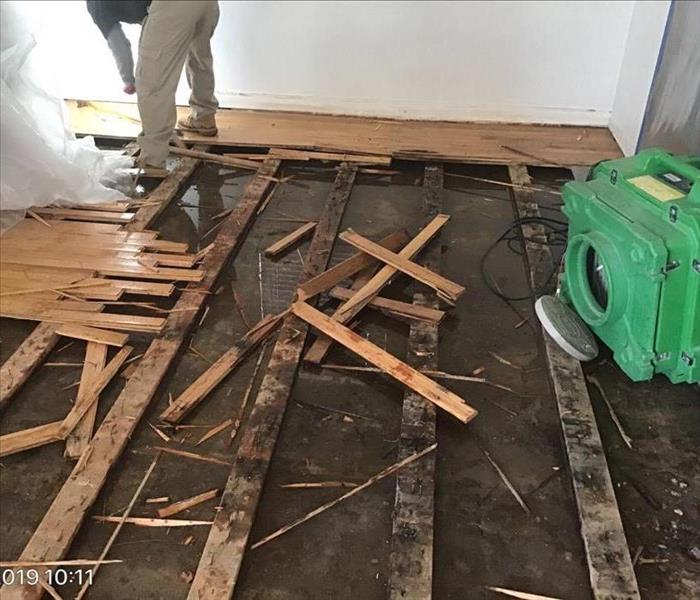 This home was affected by water damage, and our crew was there to make it "Like it never even happened"
This home was affected by water damage, and our crew was there to make it "Like it never even happened"
Water damage can be a huge hassle if not handled correctly. A surprise flood or leak can cause major issues with your walls, flooring, and furniture. When you are faced with excess water in your home, here are three things to keep in mind when facing water damage:
- Don’t wait to get help. It is important to get help as quickly as possible from a professional service to prevent major water damage in your home. The sooner you call a reliable team experienced in water damage restoration, the better. Getting the situation taken care of as soon as possible will prevent mold growth and other serious problems in your home.
- Start drying the area right away. The more you can dry the affected areas, the better. Mopping up extra water with towels and rags will help the area dry faster. When drying the area, don’t use a vacuum to remove water or use other fans or electrical appliances as they can be potentially dangerous.
- The damage can spread deeper than the surface. Even if you clean up all the standing water, it is likely that more water seeped through the floor and baseboards. If this extra water underneath your floor is not taken care of, it can quickly become a bigger problem, leading to mold and damage to the structure of your home.
If you are faced with unexpected flooding or leaks and are worried about water damage, give SERVPRO of East Brownsville & South Padre Island. We can help take care of the situation quickly, so you won’t have water damage to worry about in the future. Give us a call today!
What can be restored from water damage
5/1/2019 (Permalink)
 SERVPRO Professionals Extracting water in our customers home
SERVPRO Professionals Extracting water in our customers home
When your home has been affected by water damage, you may be tempted to want to throw everything in the trash and start over. Water damage can have devastating effects and can be difficult to clean and restore a property to its original state. Fortunately, at SERVPRO of East Brownsville & South Padre Island, we are experts at restoration from water damage and can help guide you when it comes to restoring your home after an accident.
The good news is, plenty of things can be saved and restored after being affected by water. However, a lot of this depends on quick action on the part of the property owner. The longer a home goes without being treated, the worse the damage becomes. Mold begins to grow in the damp environment and can be irreversibly damaging. Mold spores can begin to spread throughout the home and linger in the air, where it can be inhaled and cause negative health effects to the inhabitants. The sooner you act to rid your home of water damage, the better. At SERVPRO, we offer 24-hour emergency service, so we can begin the cleanup process right away.
Some things should not be kept after having been subjected to extreme water damage. Things like mattresses, box springs, pillows, particle board and other similar items tend to harbor moisture and foster the growth of microbes. We recommend replacing items like this to prevent illness and the spread of microbes in the future. If you are unsure of whether you should toss something or not, we are happy to consult with you.
Water damage in your home is a frustrating experience to live through, but if you work with us at SERVPRO of East Brownsville & South Padre Island, you can be sure that your home will be restored to its original beauty.
Water Damage: What To Do After A Flash Flood.
1/8/2019 (Permalink)
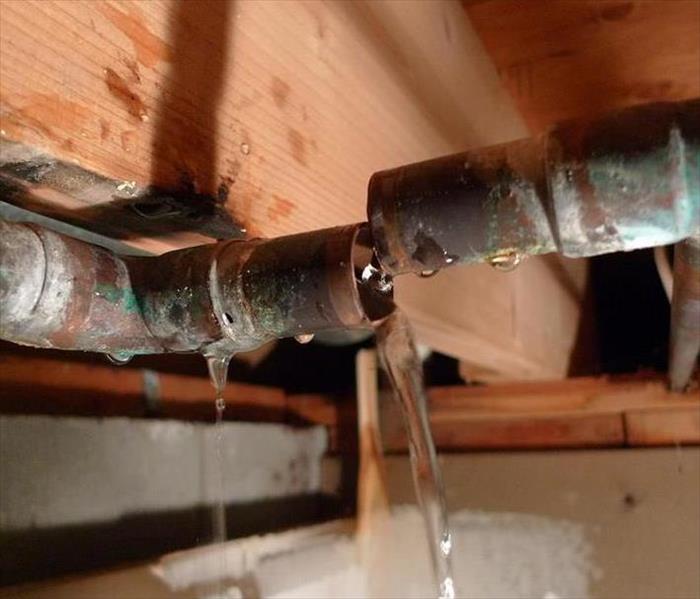 Pipe leaks in home cause serious damage.
Pipe leaks in home cause serious damage.
In an instant, Mother nature's rains can inflict total destruction. This could result in a cracked water pipe that is constantly flooding out your home. Water damage in your living space is very serious. Your first step should always be to find the water source and try to stop it. SERVPRO of East Brownsville & South Padre Island would like to provide you a few quick fixes that you can do to try while you wait for the items to be repaired.
1. Pump Out The Water
The first thing you’ll want to do if you have standing water from flood damage is get rid of it. Pumping out the water with a sump pump will help drain most of the water. Once the water’s drained, you can start analyzing the damage, and once the water levels are down, call the Fire And Water Clean-up & Restoration team at SERVPRO Of East Brownsville & South Padre Island.
2. Restoring Flooring
If your hardwood flooring, tile or carpeting had a lot of standing water on it, it’s important to determine if you can repair it or if you need to replace it. Before you decide to rip the carpet out, call the pros at SERVPRO. we will be able to save your wet, soiled carpeting with our powerful extraction process. Even Hardwood flooring can be salvaged by extracting water and then immediately applying cleaning solution. From there, the wood fibers or carpeting are saturated, sanitized and water is removed. The result is a clean, bacteria-free floor or carpet that is safe to use again.
3. Try To Remove As Much Furniture As Possible
Once the water has stopped flowing in your Suwanee home, the first thing you should do is find your electrical breaker and shut the box off. This will allow you to safely go in and shut off all water valves if necessary. You’ll be able to assess the water damage in your home. Try to move wood furniture to a safe and dry location.
4. Get The Air Circulating
With small amounts of standing water and wet flooring remaining, you’ll want to get the air flowing. This is because damp spaces are a breeding ground for mold, mildew, germs and bacteria.
5. Waterproof Your Home
Once the leaks have subsided and your items have been restored, it’s time to consider waterproofing your home. A temporary fix would be to seal off any holes or spaces where water can easily enter. This may include a broken downspout, a missing roof shingle or missing flashing around your roof. From there, you may want to consider have your basement as well as the exterior base of your home waterproofed to prevent water from pooling.
floods can cause very serious damage to your home. Call the water damage experts at SERVPRO OF East Brownsville and South Padre Island right away! We will assist you with fast clean-up and flood recovery!
Thermal Imaging For Water Damage Restoration
1/7/2019 (Permalink)
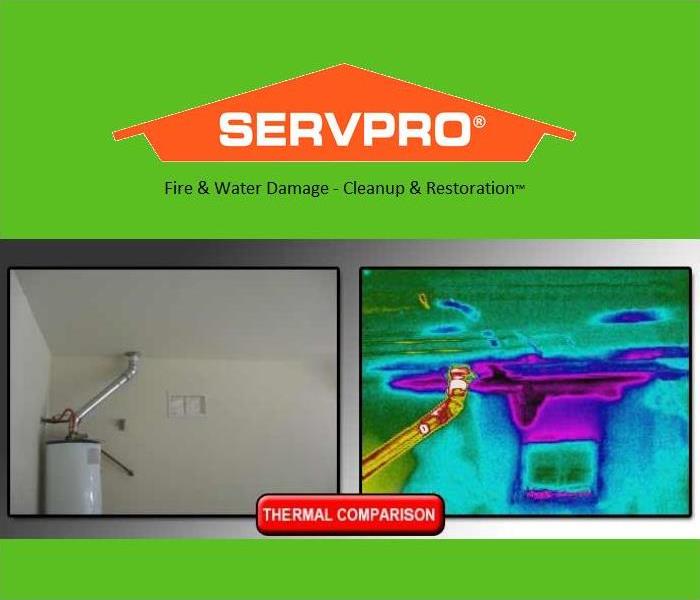 Visual representation a thermal image camera provides.
Visual representation a thermal image camera provides.
Over the years, SERVPRO Of East Brownsville & South Padre Island has been developing many tools that have help make our technician's job get done much more efficiently. One tool that we use in every job that involves water damage is the Thermal Imaging Camera A.K.A The IR Camera. Today we will be discussing more about this tool on how its used and the benefits it provides to restoration contractors.
Benefits An IR camera Brings.
Going into a job with this technology helps us build credibility with the customer. They aren't just depending on our word, they are being provided with visible evidence of what exactly the problem is and where it Is occurring.
Recent Innovations With Thermal Imaging/IR Technology.
The thermal Pro LT, brings infrared technology into our smartphone. It detects things using our mobile device that are not visible to the eye. In most cases, It may look fine to the naked eye, when in reality its NOT. Thermal imaging helps us find where the problem lies beneath the surface. For example, An area of the customers home had been affected by mold, We cant see if there is still any water accumulated in the area, so that's when the IR comes in handy. We take either a visual image or voice over video of the area, then a visual of the problem is sent right to our smartphone. We can now get to fixing the problem as soon as possible.
Four Tips/Reminders for Restoration Contractors
12/7/2018 (Permalink)
Restoration professionals like SERVPRO of East Brownsville & South Padre Island are in a 24 hour, seven days a week, 365 days a year service. On top of that, they are expected to be on site within minutes of receiving a phone call. Many professionals find themselves in a fog of chaos during the restoration process, especially in the early stages of the project. While it is understandable that things need to move quickly, unnecessary damage caused by a restoration company can cause significant setbacks for the contractor, as well as the insured and insurance carrier. Below are some things to be cognizant of during the early stages of restoration projects to limit unnecessary setback.
Proper Pack Outs
Many restoration contractors have gotten the phone call from a property owner claiming that they broke or stole something in the property. Whether or not these claims are true, doesn’t really matter at that point; the contractor has to deal with the situation and make things right. Typical mistakes mitigation companies can make include improper documentation of personal items, improper packaging of fragile items, and trying to process items that should be handled by another vendor, such as soft goods or electronics. Taking the extra time and properly packing out a property will significantly reduce these types of headaches and improve customer satisfaction.
In Place Drying
The adage of “If in doubt, rip it out!” doesn’t always apply within the restoration industry. With the different technologies and drying methods available, contractors can preserve properties better than ever. Methods such as double extraction on the carpet, blocking and padding furniture, and using pressurized drying systems, are some of the common methods employed to adequately mitigate damages, keep costs down, and reduce cycle times for completion. Always take the extra time on the emergency service call to be thorough, especially when it comes to extraction. This will reduce completion times and mitigate further damage. Remember, quicker cycle times and lower costs result in happier customers.
Avoid Cross Contamination
When contractors rush through projects, they end up getting called back out to do work they already did due to poor performance. It’s common to get called back out to a mold remediation project because of a failed post clearance or having to re-clean contents that are being processed on a fire loss because dirty items got mixed with clean. Whenever working in a clean environment, technicians need to be aware of their surroundings and make sure to follow proper protocol. Failure to follow protocol is usually a result of poor management. If managers take the extra time to ensure cleaning and remediation projects are being completed properly, they can make sure that the work is done right the first time.
Preserve Relationships
Restoration companies are in the business of protecting properties, but they can't do it alone. Contractors should not forget that while there is a job to do, bridges should not be burned in the process. Many times contractors lose sight of the picture and damage relationships in the course of business. Whether it's with an adjuster battling over pricing, or a sub-contractor that shows up late to the project, these people are all important to the success of the company. Taking extra time to connect with these individuals will pay dividends, rather than butting heads for the sake of being “right.” Remember, people continue to do business with people they like and respect.
These tips are taken seriously and are at the forefront of our minds when dealing with a new mitigation loss. SERVPRO of East Brownsville and South Padre Island strives to help property owners in their time of need and develop a strong relationship between them. Professional service and continuous communication help us deliver a less impacting experience to our customers.
Quick Response is the Key to Water Damages
5/24/2018 (Permalink)
Floods, rainstorms and tornadoes can become massive water damage threats to businesses during the often-stormy spring and summer months. Facilities plagued with such water woes this season must take quick action to control many possible problems, experts say.
You won’t see it emphasized on the nightly news when a disaster hits, but water damage can represent potentially huge disasters for businesses and building owners and operators.
Water damage can mean much more to a business than just wet and soggy carpets. There are other common, more significant problems businesses face when water wreaks havoc on property, such as indoor air quality problems. Mold and mildew grow rapidly in damp, humid environments, leaving behind an unpleasant smell that permeates floors, walls and ceilings, even after the water has been removed. It also can create health problems for employees.
Damage to the building’s structure and foundation also can be an issue. When water sits inside a building for a period of time, the walls, ceilings and floors absorb the water, which threatens the overall structural integrity of the building and creates an unsafe environment. Total reconstruction of the building often becomes the only option.
Another major threat to business is the loss of expensive equipment, which often can cost hundreds of thousands of dollars to replace.
To minimize water damage, there are two critical steps that need to be taken:
- Act fast to assess the situation; and
- Control the environment within the building.
Act Fast and Call an Expert
The absolute first step to take is fast action. Damage resulting from water and flooding is very progressive. The longer the water flows or wet conditions are allowed to exist, the greater the recovery problem becomes. A water damage consultant, such as SERVPRO of East Brownsville & South Padre Island, must come in immediately to survey the situation.
In a typical scenario, a team of water damage recovery professionals is dispatched to the site to perform a thorough inspection and fully determine the extent of the damage. A disaster reclamation partner also will develop an intense restoration plan and determine which items are worth restoring and which are better replaced.
You can’t always save everything by drying, but you can save a tremendous amount. It’s not unusual to save between 30 and 70 percent of the cost needed to reconstruct a facility.
Controlling the Interior Environment
Another key in limiting water damage is to quickly control three conditions of a building’s atmosphere: relative humidity, temperature and air circulation. Fast, effective action at this point will generally confine the damage to the area that was directly affected by the water damage event.
The most effective way to control these conditions in a high-moisture environment, especially a large facility, is to employ professional disaster drying that combines air movers with desiccant dehumidifiers.
Disaster drying often eliminates the need to rip out and replace walls, carpet, floor covering, hardwood floors and the building structure, which can be a huge expense. On top of that, you preclude the odors and staining caused by mold and mildew. These problems can come back to haunt you weeks later in a superficially dried building.
The Desiccant Way
When a facility has been severely water damaged, you need high volume desiccant dehumidifiers. Some larger desiccant dehumidifiers can pull 800 gallons of water out of a building in one day, compared to the typical small refrigeration units that remove about five gallons a day.
Many people are surprised that “solid” materials such as concrete and hard woods absorb moisture. But they do and rather quickly.
Getting the water back involves a phenomenon called migration. Migration is the tendency for water molecules to move toward a low vapor pressure. When a room is filled with very dry air, which has low vapor pressure, trapped water migrates outward and is evaporated from the surface by the dry air. As the air in the room fills with water vapor, we expel it. We then replace it with more dry air and the process continues.
It’s also essential to be sure the equipment being used is sized right. Inappropriately sized drying equipment can lead to insufficient drying and long-term problems with the building. Only large-volume dehumidifiers could provide the massive drying power needed to dry the space quickly and thoroughly.
Best Defense: An Emergency Ready Plan
To minimize damage and costs, companies need to think ahead about what to do in a water damage event and contact a water damage expert like SERVPRO of East Brownsville & South Padre Island to create an Emergency Ready Plan (ERP).
An ERP can limit the extent of water damage occurrences by defining and prioritizing the recovery of areas within a facility and stating immediate next steps. Proper planning and fast action are most certainly the best defense to preventing a catastrophic water damage event.
Drying Equipment-4 Features that Matter
5/1/2018 (Permalink)
The disaster restoration field has come a long way since its inception not so long ago. A foregleam of the RIA was established in 1946 by a group of rug cleaning professionals known then and now as the National Institute of Rug Cleaners (NIRC). Through the decades, the association arranged itself into multiple “institutes” that served different aspects of its membership, including fire and water damage. In 1980, the Association of Specialists in Cleaning in Restoration (ASCR) was formed under whose umbrella the National Institute of Fire Restoration (NIFR) was created. In the 90’s, the NIFR became the National Institute of Disaster Restoration (NIDR). And in 2007, ASCR once again rebranded itself to become the Restoration Industry Association (RIA).
What’s the point of this little trip down a memory lane of abbreviations? Just as the disaster restoration industry has improved and specialized, so has the equipment that the industry uses. The business has also gotten much more competitive, not just among contractors but between manufacturers of restoration-related equipment as well. So when it comes time for you to purchase equipment, how do you know which units to buy? SERVPRO of East Brownsville & South Padre Island has done its homework when it comes to which equipment to carry in its line.
There are many claims made by manufacturers about the effectiveness of their equipment and the majority of it is valid. But there are diverse testing methods in the industry which will sometimes skew the results depending on who is evaluating the equipment.
For instance, when it comes to CFM, some units are field tested (complete with the housing) and some are bench tested (no housing) which produces different results. Sometimes statistics are used as marketing tools, but as Mark Twain once said, “There are lies, damned lies, and statistics.” Or as an American humorist, Evan Esar wrote, “Definition of Statistics: The science of producing unreliable facts from reliable figures.”
The truth is, most of the equipment that is available for the restoration contractor is pretty good stuff. But unfortunately, some cheap knock-off units have flooded the market in recent years, so you still should do your homework. That said, it ain’t rocket science. The following are four main features you’ll want to look for the next time you’re in the market for restoration equipment. Although we’re limiting this discussion to air movers and dehumidifiers because of limited space, most of these aspects will apply to other equipment as well:
1.Power– in air movers, this is usually stated in terms of high CFM (Cubic Feet per Minute) or FPM (Feet per Minute). There are arguments about the importance of one over the other and some say a balance of both is important. But in advertising, the greater of the two numbers is usually highlighted. For dehumidifiers, high CFM is important because moisture can only be extracted from the amount of air that can be moved through the dehumidifier. So you also want to look for a high PPD @ AHAM (Association of Home Appliance Manufacturers) number to assure the water removal capacity and energy factor claimed for that dehumidifier are accurate.
2.Low amps – simply, the more equipment you can plug in, the faster the job is done. Having enough low amp equipment may even save you the expense of renting a generator for more power.
3.Durability– there used to be a commercial for American Tourister luggage that showed a gorilla abusing their suitcase (see it on YouTube) to show how their luggage takes the punishment they often receive. Unfortunately, your restoration equipment often receives like treatment. One of the best ways to ensure you’re buying a durable unit is to ask other contractors who own them how theirs have held up. If purchasing units with plastic housing, be sure that it’s made by rotation molding and not injection molded. Rotomolding gives a product uniform thickness, double wall construction, and virtually stress-free corners. Also, different parts that were once made by assembling assorted pieces can now be molded as a single part. It’s more efficient and makes a stronger product. You can tell when a unit is injection molded because it’s usually easy to push the housing in and it cracks more easily, especially in cold temperatures.
4.Safety - Most of us are used to looking for the UL (Underwriter’s Laboratory) mark to make sure our purchase doesn’t blow up in our face. In reality, there are other testers that are equally recognized and accepted — prominent among them, the ETL Listed Mark issued by the ETL SEMKO division of Intertek. Like the UL Mark, the ETL Listed Mark shows that a product has been independently tested by a Nationally Recognized Testing Laboratory (NRTL), that it has met the minimum requirements of commonly accepted product safety standards and that the manufacturer has agreed to periodic follow-up assessments to confirm its continued compliance. So look for a safety mark before purchasing. After all, having a piece of your equipment burn down a customer’s house can really ruin your day.
Don’t consider price the be-all and end-all. The old saying that you get what you pay for has a lot of truth behind it. Some units may incorporate a lot of bells and whistles, from high tech control boards to longer electrical cords. Some are more important than others, depending on your needs and wants. After all, everyone loves a choice, just like buying a car. But when there get to be too many options along with questionable statistics, your head can start to spin. So make it easy on yourself and concentrate on the four main features discussed in this article when shopping for equipment. You may not come away with the fanciest unit, but it’ll probably do a great job for you and last a long time.
SERVPRO of East Brownsville & South Padre Island has the latest drying equipment readily available. Anything from air-movers to commercial desiccant dehumidifiers, you can count on the professionals here at SERVPRO of East Brownsville & South Padre Island to be able to handle any size drying job.
Trapped Moisture--Finding and Eliminating
5/1/2018 (Permalink)
Finding and efficiently eliminating areas of trapped moisture is one of the many factors that differentiate an experienced restorer from a novice. If left untreated, these forgotten areas can lead to various forms of secondary damage and significantly complicate restorative efforts. Wet wall cavities are one of the most common hidden moisture scenarios technicians run into, and many different theories exist on how to handle these situations. Industry trade shows are full of different types of attachments and pieces of specialty equipment that claim to make drying these areas easier. Are they necessary? When and under what circumstances? What is truly the best way to dry hidden moisture inside of wall cavities?
The four variables that dictate an effective approach are:
- The presence of wet insulation (or lack thereof),
- Finish wall materials,
- The structural composition of the wall itself, and
- The presence of a pre-existing condition (or lack thereof).
First and foremost we must consider that the IICRC S500 instructs us that materials are dry once they reach predetermined drying goals, as measured with a moisture meter. If we do not open the wall cavity enough to allow the use of these tools, there is no way for us to ensure with certainty that all of the trapped moisture has been removed. Therefore, at the very least, we are using some form of invasive technique in the sense that inside of the wall cavity must be accessed. This also allows us to inspect the cavity for insulation, and if found, must be removed when wet as insulation will pack down and lose its R-Value. Unfortunately, this leads to a disruptive method of drying as the walls are removed so the wet insulation can be discarded.
Next to be considered is the material that the wall itself is composed of. In most restorative situations, we are dealing with gypsum drywall or another gypsum type assembly (such as Greenboard or similar). These materials tend to dry quickly after water damage as they have a rather high permeance factor which allows water vapor to diffuse through them. However, if the room side of the wall is covered with a finish material such as wallpaper, ceramic tile, or other vapor retarding material, drying can be hindered as these surfaces will affect the rate of evaporation of moisture within the material. In cases such as this, inspection holes can be drilled below baseboard line to force air into the cavity for drying both sides of the wall simultaneously. If this method is unsuccessful, removal or perforation of the wall finish material may be necessary as well as the installation of specialty wall cavity drying equipment.
The structural composition of the wall must be evaluated when choosing a drying method. In common residential settings, the typical scenario is 2x4 wood framing. However, in commercial settings, the presence of steel framing has the ability to pose complications as water inside the bottom track has the ability to travel great distances unnoticed. In addition, exterior building materials such as poured concrete, concrete block, and exterior wood sheathing need to be identified as they are critical to restoring to our dry standard as well. At a minimum, wall cavities need to be opened (preferably below baseboard lines) in order to direct airflow and also be able to meter these materials.
Finally, we must make absolutely sure that no preexisting conditions are hidden in the cavities we are trying to dry. Installing air movers or using specialty drying equipment to add positive pressure in these areas can cross-contaminate unaffected spaces if there is hidden microbial damage lurking inside. In addition, the possibility of lead-based paint and asbestos must be considered as well.
Normal structural drying of wall cavities can only proceed if the three aforementioned conditions are not present. If they are found, this constitutes a Special Situation per IICRC Guidelines and an Indoor Environmental Professional should be contacted to help dictate safe and effective work practices.
Restorers such as SERVPRO of East Brownsville & South Padre Island will always consider keeping the cost of reconstruction work at a minimum to benefit both the customer and insurance client. If possible, all wall cavities should be opened below baseboard lines to avoid painting large areas once restoration is complete. The caulking on baseboards should always be scored before removal to ensure that finished wall surfaces are not damaged. Also, all cuts to drywall should be made with a chalk line for a professional appearance and expedited repair time.
While considering all of the aforementioned information, the following general conclusions can be drawn:
- Wet wall cavities must be opened so direct airflow can adequately dry affected materials, and also so these materials can be measured with a moisture meter.
- If found, wet porous insulation should always be removed as it will lose its R-Value and significantly slow the drying process.
- If presented with a difficult to dry or costly finish material on an interior wall, consider a more disruptive technique from the opposite side of the wall to save on overall cost.
- On an uninsulated drywall wall with 2x4 wood framing, the use of specialty drying equipment is not needed and adds unnecessary cost to the project. Drilling inspection holes below baseboard lines and placing air movers along the wall is sufficient.
- Specialty drying equipment may be required when drying wall cavities behind cabinets or when there is a vapor retarding wall covering (ceramic tile, wallpaper, etc).
Following these simple guidelines has helped will help SERVPRO of East Brownsville & South Padre Island build the reputation of consistent and effective job processes homeowners and insurance clients alike appreciate.
IR Cameras- How to use them Properly, Ethically, and with Profitability
12/4/2017 (Permalink)
Infrared Cameras:
How to use them properly, ethically and profitably when performing water damage restoration.
Everyone has heard the old adage, “When you only have a hammer, all your problems start to look like nails.” With an infrared camera, everything can look like water damage.
SERVPRO of East Brownsville & South Padre Island realizes that IR camera technology can be a powerful tool for discovering the source of a leak, determining if there is latent moisture behind a wall after a dry-out and even to combat the potential for mold growth throughout a property.
On the other hand, if improperly used, an IR camera can be the cause of needless additional restoration work that won’t be covered by insurance providers.
And while an ethically-motivated restoration professional isn’t intentionally aiming to create a fear-based decisions in the mind of a property owner, it may not be viewed that way from their side, resulting in — minimally — a loss of trust and — at worst — a costly lawsuit.
What do they actually do?
There is a lot of confusion surrounding what infrared cameras actually do. To avoid issues resulting from this confusion, IR camera technology needs to be fully understood.
First and foremost, it must be made clear that thermal technology does not detect moisture at all. IR cameras detect temperature, display it visually, and that’s it.
An IR camera is no more capable of determining if something is wet than a mercury thermometer is when dropped in a cup of water. They do not “know” if things are wet, but they can easily measure temperature differentials, and water is extremely sensitive to these fluctuations.
Further, a home with water damage can reach a temperature equilibrium even after a water extraction has been performed. When this happens, if soaked drywall or carpet is the same temperature as the air around it, the IR camera won’t be able to “see” a temperature difference between the materials and the air.
This situation can easily be fixed by turning on the air conditioner, or even opening up a door to let in a draft. Actions like this will instantly affect the temperature of the air. These differences are then visible where evaporation is affecting the wet versus the dry sections of the home.
IR camera best practices
Beyond the technical limitations of the IR camera, there are also ethical implications for its use that should be addressed.
Due to the fact that an IR camera uses temperature and not actual moisture levels to determine if something is wet or not, less reputable restoration specialists might be tempted to take advantage of customers by using the visuals the camera provides.
Readouts near walls with cold water lines and air conditioning ductwork can create the impression that an area is water damaged when, in fact, it is only thermally cooler than its surroundings.
If used improperly or even unethically, this visual feedback from the camera can coax homeowners into further work than is actually required. Use of the camera in this manner is not only disreputable, but it’s also a lawsuit in the making.
That being said, when it comes down to selling yourself as an expert in the restoration industry, an IR camera and the visuals it provides can demonstrate to a homeowner, business owner or anyone you are working with on a loss that the added level of technology is an indication of true professionalism.
A heightened skill set, even if it’s only the perception of one technologically, can make a huge difference when trying to lock down a restoration project with clients.
Savvy homeowners won’t want to risk losing the services of an expert when they know they have a problem, and the IR camera may just make all the difference in illuminating this for them.
If used properly and ethically, the thermal photography that an IR camera produces can be an incredible tool for all aspects of a water damage loss.
But remember that it is still a tool, and should always be used in concert with other tools, such as moisture meters and testing, to ensure that not everything looks wet with water damage.
SERVPRO of East Brownsville & South Padre Island incorporates the use of IR Cameras on its water losses but backs up the findings with moisture meters. Our technicians are trained in the correct use of the IR Camera and know its limitations. Because of this, we verify our findings with meters and make sure we have all our equipment calibrated and functional at all times.
Preventing Mold with Quick Water Mitigation
5/1/2017 (Permalink)
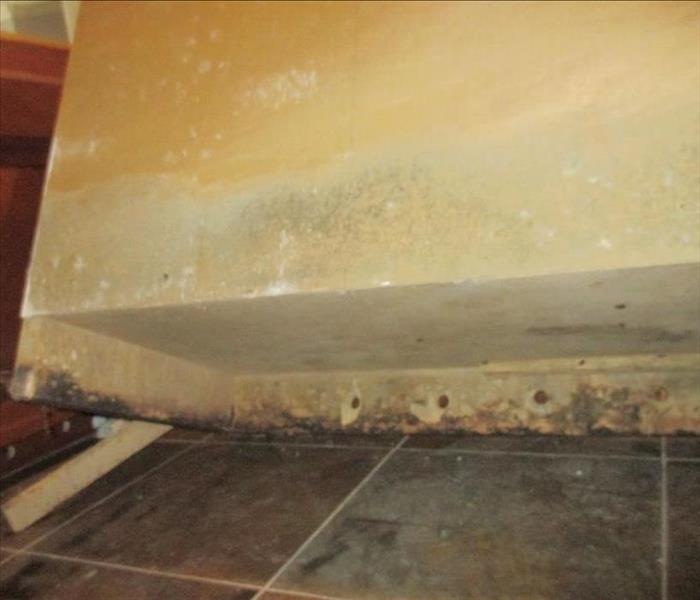 Mold Growth on cabinets
Mold Growth on cabinets
Water Management and Mold
Each homeowner should take the necessary precautions and steps to minimize the amount of moisture while redirecting water in order to reduce the risks of mold developing. Mold tends to become an issue due to water intrusion, and this has developed into a major thorn in the construction industry’s side. U.S. housing’s top indoor air quality problem is mold, which is why proper water damage mitigation ought to be taken before it runs into bigger and more serious issues such as compromised structural integrity, cosmetic problems and long-term durability issues
Mold Growth in Homes
Poor water management of a home will encourage mold growth. As mold spores are invisible to the naked eye, they tend to make their way through the home, and are always present in indoor and outdoor air. While modern homes are built in such a manner where the concentration levels are insufficient to cause issues for the home’s inhabitants, it tends to make a nuisance when it starts to grow. Mold colonies require a food source, the right temperature (above 32 degrees Fahrenheit), and plenty of moisture. These conditions are all part of a home’s make up, where plenty of organic materials abound within a temperature range that does encourage mold growth. The key to stop the spread of mold is to keep moisture levels under control, and this is where water management of a building is very important. By doing your bit to prevent water intrusion, you will be able to minimize or eliminate the possibility of mold and mildew making their presence known.
Wood-based Products
If you love all things wood, then it is all the more important to have proper water management for your home to prevent the growth of mold. Wood-based products, while adding a sense of warmth into the home’s aesthetics, require plenty of attention as wood is one material that can absorb plenty of water, resulting in a higher overall moisture content in the surrounding area. It also requires far more effort and energy to dry wood than for it to get wet. With many wood-based furniture having concealed frames that has extremely limited, if any, exposure to air, it is all the more difficult to dry out.
What is Water Management?
It is imperative that you get a reputable water restoration Company like SERVPRO, take a look just in case there is a need for water damage mitigation works to be done. The whole idea of water management is to ensure all water will be directed away from the home. This is achieved through having a positive drainage system. It is always better that water is drained out and away from the home as fast as possible.Nothing should be left to chance, which means there should not be any part of the home that is sloped in the direction of the home’s interior.
Shingling
The roof is the primary form of protection against rain, and as rainwater subjects itself to the laws of physics and gravity, it will take the path of least resistance down the exterior finish and the drainage plane. Along the way, it will come into contact with the likes of the finish roofing and wall cladding, window flanges, as well as flashing. These materials will then need to be layered in a strategic manner so that water on the outermost layers will remain a distance away from the sheathing and framing. This kind of layering method is known as shingling. Hence, all drainage planes ought to have the shingle strategy applied.
Contact SERVPRO of East Brownsville & SPI Today
If you would like to make sure that your home is a place where happy memories are made and living in it is a joy ; We have the necessary expertise and wealth of experience to be able to let you know what needs to be fixed. Our comprehensive range of services include mold remediation, water damage mitigation, and Water Damage Restoration
Water Damage in your Brownsville and South Padre Island Area
4/11/2017 (Permalink)
 Water damage in the garage.
Water damage in the garage.
Flooding and water emergencies don’t wait for regular business hours and neither do we. SERVPRO of East Brownsville & South Padre Island provides emergency cleaning and restoration services 24 hours a day, 7 days a week—including all holidays.
Faster To Any Size Disaster
Flooding and water damage is very invasive. Water quickly spreads throughout your home and gets absorbed into floors, walls, furniture, and more. SERVPRO of Brownsville & South Padre Island arrives quickly and starts the water extraction process almost immediately. This immediate response helps to minimize the damage and the cleaning and restoration costs.
Need Emergency Service? Call Us 24/7 – 956-747-3020
Water Damage Timeline
Within Minutes
- Water quickly spreads throughout your property, saturating everything in its path.
- Water is absorbed into walls, floors, upholstery, and belongings.
- Furniture finishes may bleed, causing permanent staining on carpets.
- Photographs, books, and other paper goods start to swell and warp.
Hours 1 - 24:
- Drywall begins to swell and break down.
- Metal surfaces begin to tarnish.
- Furniture begins to swell and crack.
- Dyes and inks from cloth and paper goods spread and stain.
- A musty odor appears.
48 Hours to 1 Week:
- Mold and mildew may grow and spread.
- Doors, windows, and studs swell and warp.
- Metal begins to rust and corrode.
- Furniture warps and shows signs of mold.
- Paint begins to blister.
- Wood flooring swells and warps.
- Serious biohazard contamination is possible.
More Than 1 Week:
- Restoration time and cost increase dramatically; replacing contaminated materials and structural rebuilding may be extensive.
- Structural safety, mold growth, and biohazard contaminants pose serious risks to occupants.
About SERVPRO of East Brownsville & South Padre Island
SERVPRO of East Brownsville & South Padre Island specializes in the cleanup and restoration of residential and commercial property after a fire, smoke or water damage event. Our staff is highly trained in property damage restoration. From initial and ongoing training at SERVPRO’s corporate training facility to regular IICRC-industry certification, rest assured our staff is equipped with the knowledge to restore your property.






 24/7 Emergency Service
24/7 Emergency Service

